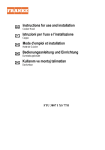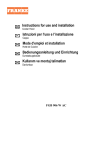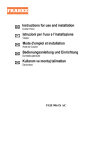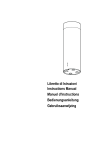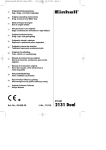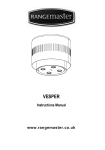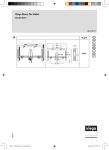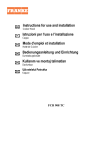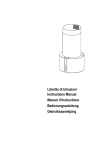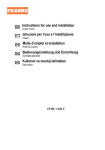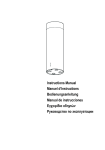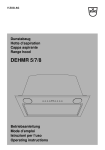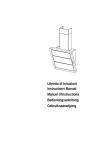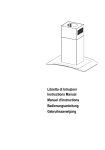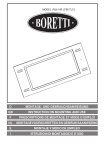Download Instructions for use and installation Istruzioni per l`uso e l
Transcript
GB Instructions for use and installation IT Istruzioni per l’uso e l’installazione FR Mode d’emploi et installation DE Bedienungsanleitung und Einrichtung TR Kullanım ve montaj talimatları CZ Cooker Hood Cappa Hotte de Cuisine Dunstabzugshaube Davlumbaz Uživatelská Pøíruèka Odsavač par FTU 3807 I XS 77H V2 INDEX EN RECOMMENDATIONS AND SUGGESTIONS ..................................................................................................................... 3 CHARACTERISTICS ............................................................................................................................................................. 4 INSTALLATION...................................................................................................................................................................... 6 USE ...................................................................................................................................................................................... 10 MAINTENANCE ................................................................................................................................................................... 11 INDICE IT CONSIGLI E SUGGERIMENTI............................................................................................................................................ 14 CARATTERISTICHE............................................................................................................................................................ 15 INSTALLAZIONE ................................................................................................................................................................. 17 USO...................................................................................................................................................................................... 21 MANUTENZIONE ................................................................................................................................................................ 22 SOMMAIRE FR CONSEILS ET SUGGESTIONS.......................................................................................................................................... 25 CARACTERISTIQUES......................................................................................................................................................... 26 INSTALLATION.................................................................................................................................................................... 28 UTILISATION ....................................................................................................................................................................... 32 ENTRETIEN......................................................................................................................................................................... 33 INHALTSVERZEICHNIS DE EMPFEHLUNGEN UND HINWEISE ................................................................................................................................... 36 CHARAKTERISTIKEN ......................................................................................................................................................... 37 MONTAGE ........................................................................................................................................................................... 39 BEDIENUNG........................................................................................................................................................................ 43 WARTUNG........................................................................................................................................................................... 44 IÇERIKLER TR TAVSIYELER VE ÖNERILER.............................................................................................................................................. 47 ÖZELLIKLER........................................................................................................................................................................ 48 MONTAJ............................................................................................................................................................................... 50 KULLANIM ........................................................................................................................................................................... 54 BAKIM .................................................................................................................................................................................. 55 OBSAH CZ RADY A DOPORUČENÍ ...................................................................................................................................................... 58 HLAVNÍ PARAMETRY......................................................................................................................................................... 59 INSTALACE ......................................................................................................................................................................... 61 POUŽITÍ ............................................................................................................................................................................... 65 ÚDRŽBA............................................................................................................................................................................... 66 2 2 RECOMMENDATIONS AND SUGGESTIONS The Instructions for Use apply to several versions of this appliance. Accordingly, you may find descriptions of individual features that do not apply to your specific appliance. INSTALLATION • The manufacturer will not be held liable for any damages resulting from incorrect or improper installation. • The minimum safety distance between the cooker top and the extractor hood is 650 mm (some models can be installed at a lower height, please refer to the paragraphs on working dimensions and installation). • Check that the mains voltage corresponds to that indicated on the rating plate fixed to the inside of the hood. • For Class I appliances, check that the domestic power supply guarantees adequate earthing. Connect the extractor to the exhaust flue through a pipe of minimum diameter 120 mm. The route of the flue must be as short as possible. • Do not connect the extractor hood to exhaust ducts carrying combustion fumes (boilers, fireplaces, etc.). • If the extractor is used in conjunction with non-electrical appliances (e.g. gas burning appliances), a sufficient degree of aeration must be guaranteed in the room in order to prevent the backflow of exhaust gas. The kitchen must have an opening communicating directly with the open air in order to guarantee the entry of clean air. When the cooker hood is used in conjunction with appliances supplied with energy other than electric, the negative pressure in the room must not exceed 0,04 mbar to prevent fumes being drawn back into the room by the cooker hood. • In the event of damage to the power cable, it must be replaced by the manufacturer or by the technical service department, in order to prevent any risks. • If the instructions for installation for the gas hob specify a greater distance specified above, this has to be taken into account. Regulations concerning the discharge of air have to be fulfilled. 2° USE • • • • • • • • • The extractor hood has been designed exclusively for domestic use to eliminate kitchen smells. Never use the hood for purposes other than for which it has been designed. Never leave high naked flames under the hood when it is in operation. Adjust the flame intensity to direct it onto the bottom of the pan only, making sure that it does not engulf the sides. Deep fat fryers must be continuously monitored during use: overheated oil can burst into flames. Do not flambè under the range hood; risk of fire This appliance is not intended for use by persons (including children) with reduced physical, sensory or mental capabilities, or lack of experience and knowledge, unless they have been given supervision or instruction concerning use of the appliance by a person responsible for their safety. Children should be supervised to ensure that they do not play with the appliance. “ CAUTION: Accessible parts may become hot when used with cooking appliances.”. MAINTENANCE • Switch off or unplug the appliance from the mains supply before carrying out any maintenance work. • Clean and/or replace the Filters after the specified time period (Fire hazard). • Clean the hood using a damp cloth and a neutral liquid detergent. The symbol on the product or on its packaging indicates that this product may not be treated as household waste. Instead it shall be handed over to the applicable collection point for the recycling of electrical and electronic equipment. By ensuring this product is disposed of correctly, you will help prevent potential negative consequences for the environment and human health, which could otherwise be caused by inappropriate waste handling of this product. For more detailed information about recycling of this product, please contact your local city office, your household waste disposal service or the shop where you purchased the product. EN 3 3 CHARACTERISTICS * ** Dimensions Min. Min. 550mm 550mm * Dimensions of the hood in ducting version. ** Dimensions of the hood in recycling version. EN 4 4 Components Ref. 1 2 7.1 7.1a 7.1b 9 10 15 25 Q.ty Product Components 1 Hood Body, complete with: Controls, Light, Blower, Filters 1 Chimney Upper 1 Telescopic frame complete with extractor, consisting of: 1 Upper frame 1 Lower frame 1 Reducer Flange ø 150-120 mm 1 Flange ø 120 mm 1 Recirculation Air Outlet Connection Pipe clamps (not included) Ref. 11 12c 12f 12g 12h 21 22 23 Q.ty 4 4 4 4 4 1 4 4 Installation Components Wall Plugs ø 10 Screws 2,9 x 6,5 Screws M6 x 10 Screws M6 x 80 Screws 5,2 x 70 Drilling template 6.4 mm int. dia washers M6 nuts 21 12c 23 22 12g 11 15 12h 10 7.1a 25 9 7.1 7.1b 2 Q.ty Documentation 1 Instruction Manual 1 12f EN 5 5 INSTALLATION Drilling the Ceiling/shelf and fixing the frame DRILLING THE CEILING/SHELF • Use a plumb line to mark the centre of the hob on the ceiling/support shelf. • Place the drilling template 21 provided on the ceiling/support shelf, making sure that the template is in the correct position by lining up the axes of the template with those of the hob. • Mark the centres of the holes in the template. • Drill the holes at the points marked: • For concrete ceilings, drill for plugs appropriate to the screw size. • For hollow brick ceilings with wall thickness of 20 mm: drill ø 10 mm(immediately insert the Dowels 11 supplied). • For wooden beam ceilings, drill according to the wood screws used. • For wooden shelf, drill ø 7 mm. • For the power supply cable feed, drill ø 10 mm. • For the air outlet (Ducted Version), drill according to the diameter of the external air exhaust duct connection. • Insert two screws of the following type, crossing them and leaving 4-5 mm from the ceiling: • For concrete ceilings, use the appropriate plugs for the screw size (not provided). • for Cavity ceiling with inner space, with wall thickness of approx. 20 mm, Screws 12h, supplied. • For wooden beam ceilings, use 4 wood screws (not provided). • For wooden shelf, use 4 screws 12g with washers 22 and nuts 23, provided. EN 6 6 PREPARATION OF THE FRAME FOR THE HOOD IN RECYCLING VERSION A In case the hood is used in recycling version it is necessary to prepare the frame with all the necessary connection pieces. In order to make the installation easier it is necessary to lengthen the frame: • Unscrew the two screws 2.1 fixing the upper chimney to the frame and pull the chimney out. • Unscrew the four safety screws placed at the top in the frame separation area. (A). • Unscrew the eight metric screws connecting the two columns, placed on both sides of the frame (B). Installation of components in recycling version: • Fix the recycling air outlet piece 15 to the upper part of the frame using four 12c screws supplied with the hood. • Fix the flange (ø120) 10 to the lower part of the recycling air outlet 15. • Put the reducer flange 9 on the hood body outlet. • At this point, join the flanges with a pipe. In order to calculate the height of the pipe it is necessary to estimate the height of the hood (mm) and subtract 615 mm. (H pipe = H hood-615). • Lengthen the frame so that the pipe can be inserted. Place the pipe between the two flanges and block it. Make sure that the height of the frame is correct considering the height of the cooker hood (H frame = H hood – 184). Adjust the height of the frame and tighten again the earlier removed screws. Tighten again the safety screws in order to give more stability to the structure. • Fix the pipe with the pipe clamps 25 supplied with the hood. B 12c 15 10 WARNING: For the Recirculation version only: remove the sticker from the slots on the upper chimney! EN 7 7 FIXING THE FRAME • Lift the frame up, making sure that the index over the frame plate is turned forwards. • Fit the frame slots onto the two screws inserted in the ceiling as above, and turn until reaching the centre of the adjustment slot. • Tighten the two screws and fasten the other two screws provided; before locking the screws completely, it is possible to adjust the frame by turning it, making sure that the screws do not come out of their housing in the adjustment slot. • The Frame must be securely fastened so as to support both the weight of the Hood and the stress caused by occasional axial pressure against the fitted Appliance. After fixing, make sure that the base is stable even when the Frame is subjected to lateral stress. • If the Ceiling is not strong enough in the area where the hood is to be fixed, the Installer must strengthen the area using suitable plates and counterplates anchored to resistant structures. 2 1 1 2 Ducted version air exhaust system Connection When installing the ducted version, connect the hood to the chimney using either a flexible or rigid pipe ø 150 or 120 mm, the choice of which is left to the installer. • To install a ø 120 mm air exhaust connection, insert the reducer flange 9 on the hood body outlet. • Fix the pipe using the pipe clamps 25 (not provided). • Remove any activated charcoal filters. EN 9 ø 150 ø 120 8 8 Installing of the chimney and fixing of the hood When the hood is installed in recycling version the chimney has to be positioned with the slots upwards. When the hood is installed in ducting version it has to be positioned in the opposite way. • Place the chimney on the frame and fix it to the upper part of it with the earlier removed screws. When installing the hood in recycling version make sure that the slots correspond to the air outlet of the recycling air outlet piece 15. • Open the lighting unit by slightly pulling the notch. Remove the unit from the hood by sliding the fixing pivot. • Remove the filter pushing it towards the back side of the hood unit and simultaneously pulling downwards. • Remove possible charcoal filters. • In order to fix the hood body to the frame insert the 4 screws 12f in their seats. It is necessary to leave at least 4-5 mm gap between the screw heads and the frame plate. • Hook the hood canopy to the frame and turn it to the left until it reaches the stop, then lock the screws immediately to prevent the hood canopy from falling out accidentally. 1 2 Electrical connection • Connect to hood to the mains supply through a double pole switch with at least 3 mm clearance between the contacts. • Make sure that the connecting piece of the cable is correctly put in the socket. • Connect the Cmd-connectors of the controls. • Connect the Lux-connectors of the lighting system. • In the recycling hood put the charcoal filter in its place. • Put the metal grease filter and the confort panel into their proper seats. Lux Cmd EN 9 9 USE A D B C E F G H Control panel Button A B C D E F G H EN Function Turns the suction motor on and off at speed one. Decreases the working speed. Increases the working speed. Activate intensive speed from any other speed, including motor off. This speed is set to operate for 10 minutes, after which the system returns to the speed that was set before. Suitable to deal with maximum levels of cooking fumes. Press and hold the button for approximately 5 seconds, with all the loads turned off (Motor and Lights), to turn the Activated Charcoal Filter alarm On and Off. 24H function Turns the suction motor on at speed one and effects one 10 minute extraction every hour. When the filters alarm is triggered, the alarm can be reset by pressing and holding this button for approximately 3 seconds. These indications are only visible when the motor is turned off. Display Displays the set speed Displays the set speed Displays the set speed Displays HI and the time remaining once very second. FC+Punto (2 flashes)–Alarm On. FC+Punto (1 flash)–Alarm Off. Displays 24 and the spot at the bottom right flashes once every second, while the motor is running. It is disabled by pressing the button. FF flashes three times. When the procedure terminates, the indication shown previously turns off: FG indicates the need to wash the metal grease filters. The alarm is triggered after the Hood has been in operation for 100 working hours. FC indicates the need to change the activated charcoal filters, and also to wash the metal grease filters. The alarm is triggered after the Hood has been in operation for 200 working hours. Displays the operating speed and the spot at the bottom right flashes once a second. Delay function Activate automatic switch-off with a 30’ delay. Suitable to complete elimination of residual odours. Can be activated from any position, and is disabled by pressing the button or turning the motor off. Press and hold the button for approximately 5 IR+Punto (2 flashes)–Alarm On. seconds, with all the loads turned off (Motor and IR+Punto (1 flash)–Alarm Off. Lights), to turn the Remote Control On and Off. Turns the lighting system on and off at maximum intensity. Turns the Courtesy Lighting on and off. 1 10 MAINTENANCE REMOTE CONTROL (OPTIONAL) The appliance can be controlled using a remote control powered by a 1.5 V carbon-zinc alkaline batteries of the standard LR03AAA type (not included). • Do not place the remote control near to heat sources. • Used batteries must be disposed of in the proper manner. Cleaning the Comfort Panels • Pull the Comfort Panel to open it. • Disconnect the panel from the hood canopy by sliding the fixing pin lever. • The comfort panel must never be washed in a dishwasher. • Clean the outside by using a damp cloth and neutral liquid detergent. • Clean the inside as well by using a damp cloth and neutral detergent; do not use wet cloths or sponges, or jets of water; do not use abrasive substances. • When the above operation has been completed, hook the panel back to the hood canopy and close it by turning the knob in the opposite direction. EN 1 11 Metal grease filters They can be washed in the dishwasher, and need to be cleaned whenever the FG sign appears on the display or at least once every 2 months use, or more frequently if use is particularly intensive. Resetting the alarm signal • Turn the Lights and the Suction motor off, then disable the 24h function, if enabled. • Press button E (see the paragraph on Use). Cleaning the Filters • Open the lighting unit by pulling on the nocth. • Remove the Filters one at a time, pushing them towards the back of the unit and at the same time pulling downward. • Wash the Filters without bending them, and leave them to dry completely before replacing. (If the surface of the filter changes colour as time goes by, this will have absolutely no effect on the efficiency of the filter itself.) • Replace, taking care to ensure that the handle faces forwards. • Replace the lighting unit. EN 1 12 Activated Charcoal Filter (Recirculation Version) It cannot be washed or regenerated, and must be changed when the FC symbol on the display appears, or at least once every 4 months. The Alarm signal, if it has been activated, only appears when the Suction motor is turned on. Activating the alarm signal • In Recirculation Version Hoods, the Filter Saturation Alarm must be activated on installation or at a later date. • Turn the Lights and the Suction Motor off. • Press D and hold for approximately 5 Seconds: • The message FC+Puntino flashes twice, A.C. Filter saturation alarm ACTIVATED • The message FC+Puntino flashes once, A.C. Filter saturation alarm DEACTIVATED CHANGING THE ACTIVATED CHARCOAL FILTER Resetting the alarm signal • Turn the Lights and the Suction motor off, then disable the 24h function, if enabled. • Press button E (see paragraph on Use). Changing the Filter • Open the lighting unit by pulling on the notch provided. • Remove the Metal grease filters. • Remove the saturated Activated charcoal filter, using the hooks provided. • Fit the new Filter, hooking it into place. • Replace the Metal grease filters. • Close the lighting unit again. Lighting LIGHT REPLACEMENT 20 W halogen light. • Remove the 2 screws fixing the Lighting support, and pull it out of from the Hood. • Extract the lamp from the Support. • Replace with another of the same type, making sure that the two pins are properly inserted in the lamp holder socket holes. • Refit the Support, fixing it in place with the two screws removed as above. EN 1 13 CONSIGLI E SUGGERIMENTI Questo libretto di istruzioni per l'uso è previsto per più versioni dell' apparecchio. É possibile che siano descritti singoli particolari della dotazione, che non riguardano il Vostro apparecchio. INSTALLAZIONE • Il produttore declina qualsiasi responsabilità per danni dovuti ad installazione non corretta o non conforme alle regole dell’arte. • La distanza minima di sicurezza tra il Piano di cottura e la Cappa deve essere di 650 mm, (alcuni modelli possono essere installati ad un’altezza inferiore, fare riferimento ai paragrafi ingombro e installazione). • Verificare che la tensione di rete corrisponda a quella riportata nella targhetta posta all’interno della Cappa. • Per Apparecchi in Classe Ia accertarsi che l’impianto elettrico domestico garantisca un corretto scarico a terra. • Collegare la Cappa all’uscita dell’aria aspirata con tubazione di diametro pari o superiore a 120 mm. Il percorso della tubazione deve essere il più breve possibile. • Non collegare la Cappa a condotti di scarico dei fumi prodotti da combustione (caldaie, caminetti, ecc.). • Nel caso in cui nella stanza vengano utilizzati sia la Cappa che apparecchi non azionati da energia elettrica (ad esempio apparecchi utilizzatori di gas), si deve provvedere ad una aerazione sufficiente dell’ambiente. Se la cucina ne fosse sprovvista, praticare un’apertura che comunichi con l’esterno, per garantire il richiamo d’aria pulita. Un uso proprio e senza rischi si ottiene quando la depressione massima del locale non supera i 0,04 mBar. • In caso di danneggiamento del cavo alimentazione, esso deve essere sostituito dal costruttore o dal servizio di assistenza tecnica, in modo da prevenire ogni rischio. • Se le istruzioni di installazione del dispositivo di cottura a gas indicano che è necessaria una distanza maggiore di quella indicato sopra, è necessario tenerne conto. Bisogna rispettare tutte le normative relative allo scarico dell’aria. 2° USO • • • • • • • • • La Cappa è stata progettata esclusivamente per uso domestico, per abbattere gli odori della cucina. Non fare mai uso improprio della Cappa. Non lasciare fiamme libere a forte intensità sotto la Cappa in funzione. Regolare sempre le fiamme in modo da evitare una evidente fuoriuscita laterale delle stesse rispetto al fondo delle pentole. Controllare le friggitrici durante l’uso: l’olio surriscaldato potrebbe infiammarsi. Non preparare alimenti flambè sotto la cappa da cucina; pericolo d'incendio. Questo apparecchio non deve essere utilizzato da persone (bambini inclusi) con ridotte capacità psichiche, sensoriali o mentali, oppure da persone senza esperienza e conoscenza, a meno che non siano controllati o istruiti all’uso dell’apparecchio da persone responsabili della loro sicurezza. I bambini devono essere supervisionati per assicurarsi che non giochino con l’apparecchio. “ATTENZIONE: Le parti accessibili possono diventare molto calde se utilizzate con degli apparecchi di cottura”. MANUTENZIONE • Prima di procedere a qualsiasi operazione di manutenzione, disinserire la Cappa togliendo la spina elettrica o spegnendo l’interruttore generale. • Effettuare una scrupolosa e tempestiva manutenzione dei Filtri secondo gli intervalli consigliati (Rischio di incendio). • Per la pulizia delle superfici della Cappa è sufficiente utilizzare un panno umido e detersivo liquido neutro. Il simbolo sul prodotto o sulla confezione indica che il prodotto non deve essere considerato come un normale rifiuto domestico, ma deve essere portato nel punto di raccolta appropriato per il riciclaggio di apparecchiature elettriche ed elettroniche. Provvedendo a smaltire questo prodotto in modo appropriato, si contribuisce a evitare potenziali conseguenze negative per l’ambiente e per la salute, che potrebbero derivare da uno smaltimento inadeguato del prodotto. Per informazioni più dettagliate sul riciclaggio di questo prodotto, contattare l’ufficio comunale, il servizio locale di smaltimento rifiuti o il negozio in cui è stato acquistato il prodotto. IT 1 14 CARATTERISTICHE * ** Ingombro Min. Min. 550mm 550mm * Dimensioni per cappa in versione aspirante. ** Dimensioni per cappa in versione filtrante. IT 1 15 Componenti Rif. 1 2 7.1 7.1a 7.1b 9 10 15 25 Q.tà Componenti di Prodotto 1 Corpo Cappa completo di: Comandi, Luce, Filtri, Camino Inferiore 1 Camino superiore 1 Traliccio telescopico completo di Aspiratore,formato da: 1 Traliccio superiore 1 Traliccio inferiore 1 Flangia di riduzione ø 150-120 mm 1 Flangia ø 120 mm 1 Raccordo Uscita Aria Filtrante Fascette stringitubo (non incluse) Rif. 11 12c 12f 12g 12h 21 22 23 Q.tà 4 4 4 4 4 1 4 4 Componenti di Installazione Tasselli ø 10 Viti 2,9 x 6,5 Viti M6 x 15 Viti M6 x 80 Viti 5,2 x 70 Dima di foratura Rondelle ø 6,4 Dadi M6 Q.tà Documentazione 1 Libretto Istruzioni 21 12c 23 22 12g 11 15 12h 10 7.1a 25 9 7.1 7.1b 2 1 12f IT 1 16 INSTALLAZIONE Foratura Soffitto/Mensola e Fissaggio Traliccio FORATURA SOFFITTO/MENSOLA • Con l’ausilio di un Filo a piombo riportare sul Soffitto/Mensola di supporto il centro del Piano di Cottura. • Appoggiare al Soffitto/Mensola la Dima di Foratura 21 in dotazione, facendo coincidere il suo centro al centro proiettato e allineando gli assi della Dima agli assi del Piano di Cottura. • Segnare i centri dei Fori della Dima. • Forare i punti seguenti: • Soffitto in Calcestruzzo massiccio: secondo Tasselli per Calcestruzzo impiegati. • Soffitto in Laterizio a camera d’aria, con spessore resistente di 20 mm: ø 10 mm (inserire subito i Tasselli 11 in dotazione). • Soffitto in Travatura di Legno: secondo Viti per Legno impiegate. • Mensola in Legno: ø 7 mm. • Passaggio del Cavo elettrico di Alimentazione: ø 10 mm. • Uscita Aria (Versione Aspirante): secondo diametro del collegamento alla Tubazione di Evacuazione Esterna. • Avvitare, incrociandole e lasciando 4-5 mm dal soffitto, due viti: • per Calcestruzzo massiccio, Tasselli per Calcestruzzo, non in dotazione. • per Laterizio a camera d’aria, con spessore resistente di 20 mm circa, Viti 12h, in dotazione. • per Travatura di legno, Viti per legno, non in dotazione. • per Mensola in Legno, viti 12g con Rondelle 22 e Dadi 23, in dotazione. IT 1 17 PREPARAZIONE DEL TRALICCIO PER LA CONNESIONE FILTRANTE A Nel caso in cui si installi la cappa in versione filtrante bisogna predisporre nel traliccio tutti i raccordi necessari per tale versione. Per facilitare l’installazione dei particolari per la versione filtrante è necessario allungare il traliccio, procedere come segue: • Svitare le due viti che fissano il camino superiore 2.1 al traliccio e sfilare il camino. • Svitare le quattro viti di sicurezza poste in alto nella zona di separazione del traliccio. (A) • Svitare le otto viti metriche che uniscono le due colonne, poste ai lati del traliccio. (B) Installazione dei componenti per versione filtrante: • Fissare il raccordo filtrante 15 alla parte superiore del traliccio utilizzando le 4 viti 12c in dotazione. • Agganciare con movimento rotativo la flangia (ø120) 10 alla parte inferiore del raccordo filtrante 15. • Inserire la flangia di riduzione 9 sull’uscita dell’aspiratore. • A questo punto bisogna collegare le due flangie con un tubo, per calcolare l’altezza del tubo occorre stimare l’altezza della cappa (mm) e sottrarre 615 mm. (H tubo = H cappa-615). • Allungare il traliccio tanto da permettere l’inserimento del tubo e riposizionarlo bloccando il tubo tra le due flangie. Verificare se l’altezza del traliccio è adeguata all’altezza desiderata della cappa (H traliccio = H cappa – 184). Regolare l’altezza desiderata del traliccio e riavvitare le viti precedentemente tolte. Per garantire una maggiore stabilità al traliccio riavvitare le quattro viti di sicurezza sull’ultimo foro disponibile. • Fissare il tubo con le fascette stringitubo 25 in dotazione. B 12c 15 10 ATTENZIONE: Solo per la Versione filtrante rimuovere l’etichetta adesiva dalle asole sul camino superiore! IT 1 18 FISSAGGIO TRALICCIO • Sollevare il traliccio facendo attenzione che l’indice posto sopra la piastra del traliccio sia nella parte anteriore. • Incastrare le asole del traliccio sulle due viti predisposte precedentemente al soffitto e ruotare fino al centro dell’asola di regolazione. • Stringere le due viti e avvitare le altre due in dotazione; prima di serrare definitivamente le viti è possibile effettuare delle regolazioni ruotando il traliccio, facendo attenzione che le viti non escano dalla sede dell’asola di regolazione. • Il fissaggio del Traliccio deve essere sicuro in relazione sia al peso della Cappa sia alle sollecitazioni causate da occasionali spinte laterali all’Apparecchio montato. A fissaggio avvenuto verificare quindi che la base sia stabile anche se il Traliccio è sollecitato a flessione. • In tutti i casi in cui il Soffitto non fosse sufficientemente robusto sul punto di sospensione, l’Installatore dovrà provvedere a irrobustirlo con opportune piastre e contropiastre ancorate a parti strutturalmente resistenti. 2 1 1 2 Connessione Uscita aria Versione Aspirante Per installazione in Versione Aspirante collegare la Cappa alla tubazione di uscita per mezzo di un tubo rigido o flessibile di ø 150 o 120 mm, la cui scelta è lasciata all’installatore. • Per collegamento con tubo ø 120 mm, inserire la Flangia di riduzione 9 sull’Uscita del Corpo Cappa. • Fissare il tubo con adeguate fascette stringitubo 25(non incluse). • Rimuovere eventuali filtri al carbone attivo. IT 9 ø 150 ø 120 1 19 Montaggio Camino e Fissaggio Corpo Cappa Il camino va girato con le asole verso l’alto in caso di installazione della cappa in versione filtrante, viceversa con le asole verso il basso in caso di installazione in versione aspirante. • Infilare dal basso verso l’alto il Camino superiore e fissarlo nella parte superiore al Traliccio con 2 Viti tolte in precedenza, prestando attenzione nel caso di installazione filtrante che le asole del camino sia in corrispondenza dell’uscita del raccordo filtrante 15. • Aprire il gruppo illuminazione tirandolo sull’apposita intacca, sganciarlo dal corpo cappa facendo scorrere l’apposito perno di fissaggio. • Togliere il Filtro Antigrasso, spingendolo verso la parte posteriore del gruppo e tirando contemporaneamente verso il basso. • Togliere eventuali Filtri Antiodore al Carbone attivo. • Predisporre il fissaggio del corpo cappa al traliccio avvitando le 4 Viti 12f nelle apposite sedi.Lasciare almeno 4-5 mm di spazio tra la testa della vite e la piastra del traliccio. • Agganciare il corpo cappa al traliccio e ruotare verso sinistra fino alla battuta, procedere immediatamente al bloccaggio delle viti così da evitare un’accidentale caduta del corpo cappa. 1 2 Connessione elettrica • Collegare la Cappa all’Alimentazione di Rete interponendo un Interruttore bipolare con apertura dei contatti di almeno 3 mm. • Assicurarsi che il connettore del Cavo di alimentazione sia correttamente inserito nella presa dell’Aspiratore • Collegare i connettori dei Comandi Cmd. • Collegare i connettori dei Faretti Lux. • Per la Versione Filtrante montare il Filtro Antiodore al Carbone attivo. • Rimontare il Filtro Antigrasso e successivamente il pannello aspirante. Lux Cmd IT 2 20 USO A D B C E F G H Quadro comandi Tasto Funzione A Accende e spegne il motore di aspirazione alla prima velocità. B Decrementa la velocità di esercizio. C Incrementa la velocità di esercizio. D Attiva la velocità Intensiva da qualsiasi velocità anche da motore spento, tale velocità è temporizzata a 10 minuti, al termine del tempo il sistema ritorna alla velocità precedentemente impostata. Adatta a fronteggiare le massime emissioni di fumi di cottura. Tenendo il tasto premuto per circa 5 secondi, quando tutti i carichi sono spenti (Motore+Luce), si Attiva / Disattiva l’allarme dei Filtri al Carbone attivo. E Funzione 24H Attiva il motore alla prima velocità e consente un’aspirazione di 10 minuti ogni ora. Con l’allarme filtri in corso premendo il tasto per circa 3 secondi si effettua il reset dell’allarme. Tali segnalazioni sono visibili solo a motore spento. F G H IT Display Visualizza la velocità impostata Visualizza la velocità impostata Visualizza la velocità impostata Visualizza alternamente HI e il tempo rimanente una volta al secondo. FC+Punto (2Lampeggi)–Allarme Attivo. FC+Punto (1Lampeggio)–Allarme Disattivo. Visualizza 24 e il punto in basso a destra lampeggia una volta al secondo, mentre il motore è in funzione. Si disabilita premendo il tasto. Lampeggia FF tre volte. Terminata la procedura si spegne la segnalazione precedentemente visualizzata: FG segnala la necessità di lavare i filtri antigrasso metallici. L’allarme entra in funzione dopo 100 ore di lavoro effettivo della Cappa. FC segnala la necessità di sostituire i filtri al carbone attivo e devono anche essere lavati i filtri antigrasso metallici. L’allarme entra in funzione dopo 200 ore di lavoro effettivo della Cappa. Funzione Delay Visualizza la velocità di esercizio e il punto in basso a Attiva lo spegnimento automatico ritardato di 30’. destra lampeggia una volta al secondo. Adatto per completare l’eliminazione di odori residui. Attivabile da qualsiasi posizione, si disattiva premendo il tasto o spegnendo il motore. Tenendo il tasto premuto per circa 5 secondi, quando IR+Punto (2Lampeggi)–Allarme Attivo. tutti i carichi sono spenti (Motore+Luce), si Attiva / IR+Punto (1Lampeggio)–Allarme Disattivo. Disattiva il Telecomando. Accende e spegne l’impianto di illuminazione alla massima intensità. Accende e spegne l’impianto di illuminazione in modalità Luce di Cortesia. 2 21 MANUTENZIONE TELECOMANDO (OPZIONALE) Questo apparecchio può essere comandato per mezzo di un telecomando, alimentato con pile alcaline zinco-carbone da 1,5 V del tipo standard LR03-AAA (non incluse). • Non riporre il telecomando in prossimità di fonti di calore. • Non disperdere le pile nell’ambiente, depositarle negli appositi contenitori. Pulizia dei Comfort Panel • Aprire il Comfort Panel tirandolo. • Sganciare il pannello dal corpo cappa facendo scorrere l’apposita leva del perno di fissaggio. • Il comfort panel non va assolutamente lavato in lavastoviglie. • Pulirlo esternamente con un panno umido e detersivo liquido neutro. • Pulirlo anche internamente utilizzando un panno umido e detergente neutro; non utilizzare panni o spugne bagnate, né getti d’acqua; non utilizzare sostanze abrasive. • Ad operazione ultimata riagganciare il pannello al corpo cappa e richiuderlo. . IT 2 22 Filtri antigrasso metallici Sono lavabili anche in lavastoviglie, e necessitano di essere lavati quando sul display appare FG o almeno ogni 2 mesi circa di utilizzo o più frequentemente, per un uso particolarmente intenso. Reset del segnale di allarme • Spegnere le Luci e il Motore di aspirazione, quindi qualora fosse attivata la funzione 24h disattivarla. • Premere il tasto E (Vedi paragrafo Uso). Pulizia Filtri • Aprire il gruppo illuminazione tirandolo sull’apposita intacca. • Togliere i Filtri uno alla volta, spingendoli verso la parte posteriore del gruppo e tirando contemporaneamente verso il basso. • Lavare i Filtri evitando di piegarli, e lasciarli asciugare prima di rimontarli. (Un’eventuale cambiamento del colore della superficie del filtro, che potrebbe verificarsi nel tempo, non pregiudica assolutamente l’efficienza dello stesso.) • Rimontarli facendo attenzione a mantenere la maniglia verso la parte visibile esterna. • Richiudere il gruppo illuminazione. IT 2 23 Filtri antiodore al Carbone attivo (Versione Filtrante) Non è lavabile e non è rigenerabile, va sostituito quando sul display appare FC o almeno ogni 4 mesi. La segnalazione di Allarme, se preventivamente attivata, si verifica solo quando è azionato il Motore di aspirazione. Attivazione del segnale di allarme • Nelle Cappe in Versione Filtrante, la segnalazione di Allarme saturazione Filtri va attivata al momento dell’installazione o successivamente. • Spegnere le Luci e il Motore di aspirazione. • Premere il tasto D per circa 5 Secondi: • 2 Lampeggi scritta FC+Puntino -- Allarme saturazione Filtro C.A. ATTIVATO. • 1 Lampeggio scritta FC+Puntino -- Allarme saturazione Filtro C.A. DISATTIVATO. SOSTITUZIONE FILTRO ANTIODORE AL CARBONE ATTIVO Reset del segnale di allarme • Spegnere le Luci e il Motore di aspirazione, quindi qualora fosse attivata la funzione 24h disattivarla. • Premere il tasto E (Vedi paragrafo Uso). Sostituzione Filtro • Aprire il gruppo illuminazione tirandolo sull’apposita intacca. • Togliere i Filtri antigrasso metallici. • Rimuovere il Filtro antiodore al Carbone attivo saturo, agendo sugli appositi agganci. • Montare il nuovo Filtro agganciandolo nella sua sede. • Rimontare i Filtri antigrasso metallici. • Richiudere il gruppo illuminazione. Illuminazione SOSTITUZIONE LAMPADE Lampade alogene da 20 W. • Togliere le due viti che fissano il Supporto illuminazione e sfilarlo dalla Cappa. • Estrarre la Lampada dal Supporto. • Sostituirla con una nuova di uguali caratteristiche, facendo attenzione di inserire correttamente i due spinotti nella sede del Supporto. • Rimontare il Supporto fissandola con le due Viti precedentemente tolte. IT 2 24 CONSEILS ET SUGGESTIONS La présente notice d'emploi vaut pour plusieurs versions de l'appareil. Elle peut contenir des descriptions d'accessoires ne figurant pas dans votre appareil. INSTALLATION • Le fabricant décline toute responsabilité en cas de dommage dû à une installation non correcte ou non conforme aux règles de l’art. • La distance minimale de sécurité entre le plan de cuisson et la hotte doit être de 650 mm au moins (certains modèles peuvent être installés à une hauteur inférieure : se reporter aux paragraphes « Encombrement » et « Installation »). • Vérifier que la tension du secteur correspond à la valeur qui figure sur la plaquette apposée à l’intérieur de la hotte. • Pour les Appareils appartenant à la Ière Classe, veiller à ce que la mise à la terre de l’installation électrique domestique ait été effectuée conformément aux normes en vigueur. • Connecter la hotte à la sortie d’air aspiré à l’aide d’une tuyauterie d’un diamètre égal ou supérieur à 120 mm. Le parcours de la tuyauterie doit être le plus court possible. • Ne pas connecter la hotte à des conduites d’évacuation de fumées issues d’une combustion tel que (Chaudière, cheminée, etc…). • Si vous utilisez des appareils qui ne fonctionnent pas à l’électricité dans la pièce ou est installée la hotte (par exemple: des appareils fonctionnant au gaz), vous devez prévoir une aération suffisante du milieu. Si la cuisine en est dépourvue, pratiquez une ouverture qui communique avec l’extérieur pour garantir l’infiltration de l’air pur. Pour un emploi correct et sans risque, la dépression maximum dans la pièce ne doit pas dépasser 0,04 mbar. • En cas d’endommagement du cordon d’alimentation, faites-le remplacer par le constructeur ou par le service après-vente, afin de prévenir tout risque. • Si les instructions de montage pour la plaque de cuisson au gaz spécifient une plus grande distance indiquée cidessus, cela doit être pris en compte. Règlement concernant l'évacuation d'air doivent être remplies.. 2° UTILISATION • • • • • • • • • La hotte a été conçue exclusivement pour l’usage domestique, dans le but d’éliminer les odeurs de la cuisine. Ne jamais utiliser abusivement la hotte. Ne pas laisser les flammes libres à forte intensité quand la hotte est en service. Toujours régler les flammes de manière à éviter toute sortie latérale de ces dernières par rapport au fond des marmites. Contrôler les friteuses lors de l’utilisation car l’huile surchauffée pourrait s’enflammer. Ne pas préparer d’aliments flambés sous la hotte de cuisine : risque d’incendie Cet appareil ne doit pas être utilisé par des personnes (y compris les enfants) ayant des capacités psychiques, sensorielles ou mentales réduites, ni par des personnes n’ayant pas l’expérience et la connaissance de ce type d’appareils, à moins d'être sous le contrôle et la formation de personnes responsables de leur sécurité. Les enfants doivent être surveillés pour s'assurer qu'ils ne jouent pas avec l'appareil. « ATTENTION : Les parties accessibles peuvent devenir très chaudes si utilisées avec des appareils de cuisson. » ENTRETIEN • Avant de procéder à toute opération d’entretien, retirer la hotte en retirant la fiche ou en actionnant l’interrupteur général. • Effectuer un entretien scrupuleux et en temps dû des Filtres, à la cadence conseillée (Risque d’incendie). • Pour le nettoyage des surfaces de la hotte, il suffit d’utiliser un chiffon humide et détersif liquide neutre. Le symbole sur le produit ou son emballage indique que ce produit ne peut être traité comme déchet ménager. Il doit plutôt être remis au point de ramassage concerné, se chargeant du recyclage du matériel électrique et électronique. En vous assurant que ce produit est éliminé correctement, vous favorisez la prévention des conséquences négatives pour l’environnement et la santé humaine qui, sinon, seraient le résultat d’un traitement inapproprié des déchets de ce produit. Pour obtenir plus de détails sur le recyclage de ce produit, veuillez prendre contact avec le bureau municipal de votre région, votre service d’élimination des déchets ménagers ou le magasin où vous avez acheté le produit. FR 2 25 CARACTERISTIQUES * ** Encombrement Min. Min. 550mm 550mm * Dimensions pour hotte en version aspirante. ** Dimensions pour hotte en version filtrante. FR 2 26 Composants Réf. 1 2 7.1 7.1a 7.1b 9 10 15 25 Réf. 11 12c 12f 12g 12h 21 22 23 Q.té Composants du produit 1 Corps de Hotte comprenant : Commandes, Éclairage, Filtres 1 Conduit supérieur 1 Treillis télescopique muni d’un dispositif d’aspiration et comprenant : 1 Treillis supérieur 1 Treillis inférieur 1 Flasque de réduction ø 150-120 mm 1 Flasque ø 120 mm 1 Raccord Sortie de l’Air Colliers serre-tube (non compris) Q.té Composants de l’installation 4 Chevilles ø 10 4 Vis 2,9 x 6,5 4 Vis M6 x 15 4 Vis M6 x 80 4 Vis 5,2 x 70 1 Gabarit de perçage 4 Rondelles ø 6,4 4 Écrous M6 Q.té Documentation 1 Notice d’emploi 21 12c 23 22 12g 11 15 12h 10 7.1a 25 9 7.1 7.1b 2 1 12f FR 2 27 INSTALLATION Perçage Plafond/Étagère et Fixation Treillis PERÇAGE PLAFOND/ETAGERE • À l’aide d’un Fil à plomb, reporter sur le Plafond/Étagère de support le centre du Plan de Cuisson. • Poser contre le Plafond/Étagère le Gabarit de Perçage 21 fourni avec l’appareil, en faisant coïncider son centre avec le centre projeté et en alignant les axes du Gabarit avec les axes du Plan de Cuisson. • Marquer les centres des Trous du Gabarit. • Percer les trous qui ont été marqués: • Plafond en Béton massif: en fonction des Goujons pour Béton utilisés. • Plafond en Briques avec chambre à air, avec épaisseur résistante de 20 mm: ø 10 mm (insérer immédiatement les Chevilles 11 fournies avec l’appareil). • Plafond en Poutrage en Bois: en fonction des Vis à Bois utilisées. • Étagère en Bois: ø 7 mm. • Passage du Câble électrique d’Alimentation: ø 10 mm. • Sortie Air (Version Aspirante): en fonction du diamètre de la connexion avec les Tuyaux d’Évacuation Externe. • Visser deux vis en les croisant et en laissant 4-5 mm. de distance par rapport au plafond: • pour le Béton massif, des Goujons pour Béton, non fournis avec l’appareil. • pour Briques percées, ayant une épaisseur résistante de 20 mm. environ, utiliser les Vis 12h, fournies avec l'appareil. • pour le Poutrage en bois, 4 Vis à bois, non fournies avec l’appareil. • pour l’Étagère en Bois, 4 Vis 12g avec Rondelles 22 et Écrous 23, fournis avec l’appareil. FR 2 28 PRÉPARATION DU TREILLIS POUR LE BRANCHEMENT DE LA HOTTE EN VERSION FILTRANTE En cas d’installation de la hotte en version filtrante, il faudra prédisposer tous les raccordements dans le treillis. Allonger le treillis en procédant comme suit afin de faciliter l’installation des différents composants pour la version filtrante : • Dévisser les deux vis fixant le conduit supérieur 2.1 au treillis et retirer le conduit. • Dévisser les quatre vis de sécurité situées en haut dans la zone de séparation du treillis. (A) • Dévisser les huit vis métriques unissant les deux colonnes situées sur les côtés du treillis. (B) Installation des composants pour le branchement en version filtrante : • Fixer le raccord filtrant 15 à la partie supérieure du treillis à l’aide des 4 vis 12c fournies avec l’appareil. • Avec des mouvements circulaires, accrocher la flasque (ø120) 10 à la partie inférieure du raccord filtrant 15. • Placer la flasque de réduction 9 sur la sortie du dispositif d’aspiration. • Il faut maintenant relier les deux flasques par un tube ; pour calculer la hauteur du tube, prendre la hauteur approximative de la hotte (mm) moins 615 mm. (H tube = H hotte - 615). • Allonger suffisamment le treillis pour pouvoir placer le tube puis le remettre dans sa position initiale tout en bloquant le tube entre les deux flasques. Vérifier si la hauteur du treillis est adaptée à la hauteur à la quelle on veut installer la hotte (H treillis = H hotte – 184). Régler le treillis à la hauteur désirée et resserrer les vis. Afin de garantir une plus grande stabilité au treillis, il convient de resserrer les quatre vis de sécurité sur le dernier trou disponible. • Fixer le tuyau à l’aide des colliers serre-tuyaux 25 fournis avec l’appareil. A B 12c 15 10 ATTENTION : Seulement pour la version filtrante – retirer l’étiquette hésive des ouvertures sur la cheminée supérieure ! FR ad- 2 29 FIXATION DU TREILLIS • Soulever le treillis en s’assurant que l’indicateur situé sur la plaque du treillis se trouve sur l’avant de celui-ci. • Enfoncer les fentes du treillis sur les deux vis installées d’avance au plafond et tourner jusqu’au centre de la fente de réglage. • Serrer les deux vis et visser les deux autres également fournies ; avant de serrer les vis à fond, il est possible de régler la position du treillis en le tournant tout en faisant attention que les vis ne sortent pas des fentes 2 1 1 2 • La fixation du treillis doit être sure, aussi bien du point de vue du poids de la hotte qu’en ce qui concerne les sollicitations causées par des poussées occasionnelles sur les côtés de l’appareil après le montage. Après la fixation, vérifier la bonne stabilité de la base du treillis en cas de sollicitations diverses. • Si le plafond n’est pas suffisamment robuste pour soutenir le poids de l’appareil, l’installateur devra le renforcer en posant des plaques et des contre-plaques qu’il lui faudra accrocher à des structures plus résistantes. SORTIE AIR VERSION ASPIRANTE En cas d’installation en version aspirante, brancher la hotte à la tuyauterie de sortie via un tube rigide ou flexible de ø 150 ou 120 mm, au choix de l’installateur. • En cas de branchement avec un tube de ø120 mm, insérer le flasque de réduction 9 sur la sortie du corps de la hotte. • Fixer le tuyau à l’aide des Colliers de serrage serre-tube 25 (ne fournis pas). • Retirer les éventuels filtres anti-odeur au charbon actif. FR 9 ø 150 ø 120 3 30 Assemblage du conduit et fixation du corps de la hotte En cas d’installation en version filtrante, le conduit doit être monté avec les fentes tournées vers le haut ; en cas d’installation en version aspirante, les fentes doivent être tournées vers le bas. • Passer le conduit supérieur dans le treillis et le faire coulisser d’en bas vers le haut, le fixer au treillis à l’aide des 2 vis ôtées précédemment et s’assurer que les fentes sont bien alignées avec la sortie du raccord filtrant 15. • Ouvrir le groupe éclairage en tirant sur l’entaille, le dégager du corps de la hotte en faisant coulisser le goujon de fixation. • Retirer les filtres à graisse en les poussant vers l’arrière du groupe tout en les tirant vers le bas. • Retirer les filtres Anti-odeur au charbon actif, s’ils sont montés. • Commencer à fixer le corps de la hotte au treillis à l’aide des 4 vis 12f, sans toutefois les visser à fond mais en laissant au moins 4-5 mm d’espace entre la tête de la vis et la plaque du treillis. • Accrocher le corps de la hotte au treillis et tourner à fond vers la gauche, bloquer immédiatement les vis afin d’éviter toute chute accidentelle du corps de la hotte. 1 2 Branchement électrique • Brancher la hotte au réseau électrique en interposant un interrupteur bipolaire ayant une ouverture des contacts d’au moins 3 mm. • S’assurer que le connecteur du câble d’alimentation est branché de façon correcte dans la prise du dispositif d’aspiration. • Brancher les connecteurs des Commandes Cmd. • Brancher les connecteurs des spots Lux. • Pour la version filtrante, monter le filtre anti-odeur au charbon actif. • Remonter les filtre à graisse puis le panneau aspirant. Lux Cmd FR 3 31 UTILISATION A D B C E F G H Tableau de commande Touche Fonction A Branche et débranche le moteur d’aspiration à la première vitesse B Diminue la vitesse d’exercice. C Augmente la vitesse d’exercice. D Active la vitesse Intensive à partir de n’importe quelle vitesse, même lorsque le moteur est éteint. Cette vitesse est réglée pour une durée de 10 minutes, après quoi le système retourne à la vitesse précédemment réglée. Fonction indiquée pour faire face aux pointes d’émission de fumées de cuisson. Garder la touche appuyée pendant 5 secondes, lorsque toutes les charges sont éteintes (Moteur+ Éclairage), l’alarme des filtres au charbon actif se branche/se débranche. E Fonction 24H Active le moteur à la première vitesse et permet une aspiration de 10 minutes par heure. F G H FR Affichage Affiche la vitesse réglée Affiche la vitesse réglée Affiche la vitesse réglée Affiche alternativement HI et le temps restant une fois par seconde FC+Point (2 clignotements) – Alarme activée FC+Point (1 Clignotement) – Alarme désactivée Affiche 24 et le point en bas à droite clignote une fois par seconde, alors que le moteur est en fonction. Appuyer sur la touche pour débrancher. L’alarme filtres étant activée, appuyer sur la touche pen- FF clignote trois fois. dant environ 3 secondes pour restaurer l’alarme. À la fin de la procédure, la signalisation précéCes signalisations sont visibles seulement lorsque le mo- demment affichée s’éteint : teur est arrêté. FG Signale la nécessité de laver les filtres à graisse métalliques. L’alarme entre en fonction après 100 heures de travail effectif de la hotte. FC Signale la nécessité de remplacer les filtres au charbon actif. Laver également les filtres à graisse métalliques. L’alarme entre en fonction après 200 heures de travail effectif de la hotte. Fonction Départ différé Affiche la vitesse d’exercice et le point en bas à Active le débranchement automatique différé de 30’. droite clignote une fois par seconde. Adapté pour compléter l’élimination d’odeurs résiduelles. Activable à partir de n’importe quelle position. Pour la désactiver, appuyer sur la touche ou couper le moteur. Garder la touche appuyée pendant 5 secondes, lorsque IR+Point (2 clignotements) – Alarme activée toutes les charges sont éteintes (Moteur+ Éclairage), la FC+Point (1Clignotement) – Alarme désactivée télécommande se branche/se débranche. Allume et éteint l’éclairage à l’intensité maximale. Branche et débranche l’éclairage en mode lumière de courtoisie. 3 32 ENTRETIEN TELECOMMANDE (FOURNIE SUR DEMANDE) Il est possible de commander cet appareil au moyen d’une télécommande, alimentée avec des piles alcalines zinc-charbon 1,5 V du type standard LR03-AAA (non compris). • Ne pas ranger la télécommande à proximité de sources de chaleur. • Ne pas jeter les piles; il faut les déposer dans les récipients de récolte spécialement prévus à cet effet. Nettoyage des Confort Panel • Ouvrir le Confort Panel, en tirant ce dernier. • Décrocher le panneau du corps de la hotte, en faisant coulisser le levier du goujon de fixation spécialement prévu. • En aucun cas, le confort panel ne doit être lavé au lavevaisselle. • Le nettoyer à l’extérieur à l’aide d’un chiffon humide et d’un détergent liquide neutre. • Le nettoyer également à l’intérieur, en utilisant un chiffon humide et un détergent neutre; ne pas utiliser des chiffons ou des éponges mouillées, ni des jets d’eau; ne pas utiliser des substances abrasives. • Lorsque l‘opération est achevée, accrocher à nouveau le panneau sur le corps de la hotte, puis le refermer, en tournant le bouton dans le sens inverse par rapport à l’ouverture. FR 3 33 Filtres à graisse métalliques Ils sont lavables même au lave-vaisselle et ils doivent être lavés chaque fois que le symbole FG s’affiche ou au moins tous les 2 mois d’utilisation ou plus souvent en cas d’utilisation particulièrement intensive. Reset du signal d'alarme • Éteindre les lumières et le moteur d’aspiration. Au cas où la fonction 24h serait active, il convient de la désactiver. • Appuyer sur la touche E. (Voir paragraphe utilisation). Nettoyage des filtres • Ouvrir le groupe d’éclairage en le tirant sur l’encoche prévue à cet effet. • Retirer les filtres un à un en les poussant vers la partie postérieure du groupe et en tirant en même temps vers le bas. • Laver les filtres en évitant de les plier et les laisser sécher avant de les remonter. (Un changement de couleur de la surface du filtre, susceptible de se produire avec le temps, ne nuit en rien à son efficacité). • Les remonter en veillant à ce que la poignée soit orientée vers la partie visible externe. • Refermer le groupe d’éclairage. FR 3 34 Filtres anti-odeur au charbon actif (version filtrante) Non lavable et non régénérable, il doit être remplacé à l’affichage de FC ou au moins tous les 4 mois. Le signal d’alarme, si préalablement activé, a lieu seulement lorsque le moteur d’aspiration est en marche. Activation du signal d’alarme • Dans les hottes en version filtrante, activer le signal d’alarme de saturation filtres au moment de l’installation ou après. • Éteindre les lumières et le moteur d’aspiration. • Appuyer sur la touche D pour environ 5 sec. • 2 clignotements inscription FC+Point -- Alarme saturation Filtre C.A. ACTIVÉE • 1 clignotement inscription FC+Point -- Alarme saturation Filtre C.A. DÉSACTIVÉE REMPLACEMENT DU FILTRE ANTI-ODEUR À CHARBON ACTIF Reset du signal d'alarme • Éteindre les lumières et le moteur d’aspiration. Au cas où la fonction 24h serait active, il convient de la désactiver. • Appuyer sur la touche E. (Voir paragraphe utilisation). Remplacement du filtre • Ouvrir le groupe d’éclairage en le tirant sur l’encoche prévue à cet effet. • Retirer les filtres à graisse métalliques. • Enlever le filtre anti-odeur à charbon actif saturé en intervenant sur les crochets prévus à cet effet. • Monter le nouveau filtre en l’accrochant dans son siège. • Remonter les filtres à graisse métalliques. • Refermer le groupe d’éclairage. Eclairage REMPLACEMENT LAMPES Lampe halogène de 20 W. • Retirer les 2 Vis qui fixent le Support éclairage et ôter ce dernier de la Hotte. • Extraire la Lampe du Support. • Remplacer par une nouvelle lampe possédant les mêmes caractéristiques, en veillant à ce que les deux fiches soient correctement insérées dans le logement de la Douille. • Remonter le Support en le fixant à l’aide des deux Vis précédemment retirées. FR 3 35 EMPFEHLUNGEN UND HINWEISE Diese Gebrauchsanleitung gilt für mehrere Geräte-Ausführungen. Es ist möglich, dass einzelne Ausstattungsmerkmale beschrieben sind, die nicht auf Ihr Gerät zutreffen. MONTAGE • Der Hersteller haftet nicht für Schäden, die auf eine fehlerhafte und unsachgemäße Montage zurückzuführen sind. • Der minimale Sicherheitsabstand zwischen Kochmulde und Haube muss 650 mm betragen (einige Modelle können an einer geringeren Höhe installiert werden, beziehen Sie sich dazu auf den Absatz Platzbedarf und Installation). • Prüfen, ob die Netzspannung mit dem Wert auf dem im Haubeninneren angebrachten Schild übereinstimmt. • Bei Geräten der Klasse I ist sicherzustellen, dass die elektrische Anlage des Wohnhauses über eine vorschriftsmäßige Erdung verfügt. • Das Anschlussrohr der Haube zur Luftaustrittsöffnung muss einen Durchmesser von 120 mm oder darüber aufweisen. Der Rohrverlauf muss so kurz wie möglich sein. • Die Haube darf an keine Entlüftungsschächte angeschlossen werden, in die Verbrennungsgase (Heizkessel, Kamine usw.) geleitet werden. • Werden im Raum außer der Dunstabzugshaube andere, nicht elektrisch betriebene (z.B. gasbetriebene) Geräte verwendet, muss für eine ausreichende Belüftung gesorgt werden. Sollte die Küche diesbezüglich nicht entsprechen, ist an einer Aussenwand eine Öffnung anzubringen, die Frischluftzufuhr gewährleistet. Der Gebrauch ist dann sachgemäß und sicher, wenn der max. Unterdruck des Raums nicht mehr als 0,04 mbar beträgt. • Ein schadhaftes Kabel muss vom Hersteller oder vom technischen Kundendienst ausgewechselt werden, damit jedes Risiko vermieden wird. • Wenn die Anweisungen für die Installation für die Gaskochgeräts einen größeren Abstand oben angegeben, muss dies berücksichtigt werden. Vorschriften über die Entlastung der Luft müssen erfüllt sein. BEDIENUNG 2° • Die Dunstabzugshaube ist ausschließlich zum Einsatz im privaten Haushalt und zur Beseitigung von Küchengerüchen vorgesehen. • Unsachgemäßer Einsatz der Haube ist zu unterlassen. • Große Flammen bei eingeschalteter Haube niemals unbedeckt lassen. Achtung! Große Flammen bei eingeschalteter Haube niemals unbedeckt lassen. • Die Intensivität der Flamme ist so zu regulieren, dass sie den Topfboden nicht überragt. Achtung! Frittiergeräte müssen während des Gebrauchs stets beaufsichtigt werden: Überhitztes Öl kann sich entzünden. • Frittiergeräte müssen während des Gebrauchs stets beaufsichtigt werden: überhitztes Öl kann sich entzünden. • Keine flambierten Speisen unter der Abzugshaube zubereiten: Brandgefahr. • Dieses Gerät darf nicht von Personen, auch Kindern, mit verminderten psychischen, sensorischen und geistigern Fähigkeiten, oder von Personen ohne Erfahrung und Kenntnisse benutzt werden, sofern sie nicht von für ihre Sicherheit verantwortlichen Personen beaufsichtigt und beim Gebrauch des Geräts angeleitet werden. • Kinder dürfen sich nicht unbeaufsichtigt in der Nähe des Geräts aufhalten und auf keinen Fall mit dem Gerät spielen. • “ACHTUNG: Die zugänglichen Teile können sehr heiß werden, wenn sie mit Kochgeräten eingesetzt werden.”. WARTUNG • Bevor Wartungsarbeiten durchgeführt werden, muss die Stromzufuhr zur Haube unterbrochen werden, indem der Stecker gezogen oder der Hauptschalter abgeschaltet wird. • Bei der Filterwartung müssen die vom Hersteller empfohlenen Zeiträume zum Austauschen der Filter genauestens eingehalten werden (Brandgefahr). • Zur Reinigung der Haubenflächen Wir empfehlen ein feuchtes Tuch und ein mildes Flüssigreinigungsmittel. • Bitte keine Reinigungsmittel mit Scheuermittel verwenden. Die Oberfläche wird damit verkratzt. Das Symbol auf dem Produkt oder seiner Verpackung weist darauf hin, dass dieses Produkt nicht als normaler Haushaltsabfall zu behandeln ist, sondern an einem Sammelpunkt für das Recycling von elektrischen und elektronischen Geräten abgegeben werden muss. Durch Ihren Beitrag zum korrekten Entsorgen dieses Produkts schützen Sie die Umwelt und die Gesundheit Ihrer Mitmenschen. Umwelt und Gesundheit werden durch falsches Entsorgen gefährdet. Weitere Informationen über das Recycling dieses Produkts erhalten Sie von Ihrem Rathaus, Ihrer Müllabfuhr oder dem Geschäft, in dem Sie das Produkt gekauft haben. DE 3 36 CHARAKTERISTIKEN * ** Platzbedarf Min. Min. 550mm 550mm * Abmessungen der Haube in Abluftversion. ** Abmessungen der Haube in Umluftversion. DE 3 37 Komponenten Bez. Menge Produktkomponenten 1 1 Haubenkörper komplett mit: Steuerungen, Beleuchtung, Filter, unterem Kaminteil 2 1 Oberes Kaminteil 7.1 1 Teleskopgitter komplett mit Sauggerät, bestehend aus: 7.1a 1 Oberem Gitterteil 7.1b 1 Unterem Gitterteil 9 1 Reduktionsflansch ø 150-120 mm 10 1 Flansch ø 120 mm 15 1 Filteranschlussstück Luftaustritt 25 Rohrschellen (nicht enthalten) Bez. Menge Installationskomponenten 11 4 Dübel ø 10 12c 4 Schrauben 2,9 x 6,5 12f 4 Schrauben M6 x 15 12g 4 Schrauben M6 x 80 12h 4 Schrauben 5,2 x 70 21 1 Bohrschablone 22 4 Unterlegscheiben ø 6,4 23 4 Muttern M6 Menge Dokumentation 1 Betriebsanleitung 21 12c 23 22 12g 11 15 12h 10 7.1a 25 9 7.1 7.1b 2 1 12f DE 3 38 MONTAGE Bohren der Decke/Trägerplatte und Montage des Teleskopgerüsts Achtung: Bitte beachten Sie bei der Montage das Gewicht der kompletten Haube. Die Tragfähigkeit der Decke oder alternativ der Trägerplatte für diese Zugbelastung muss vor der Montage geprüft und gegebenenfalls durch die Anbringung von geeigneten Befestigungs- oder Stabilisierungselementen hergestellt werden. Kann eine hinreichende Tragfähigkeit nicht sichergestellt werden, ist von einer Montage abzusehen. BOHREN DER DECKE/TRAGERPLATTE • Mit Hilfe eines Lots den Kochmulden-Mittelpunkt an der Decke oder Trägerplatte ermitteln und kennzeichnen. • Die mitgelieferte Bohrschablone 21 so auf die Decke/Trägerplatte legen, dass die Schablonenmitte mit dem gekennzeichneten Mittelpunkt übereinstimmt und die Schablonenseiten auf die Seiten der Kochmulde ausrichten. • Die Mitte der Schablonenbohrungen kennzeichnen. • Die gekennzeichneten Punkte bohren: • Massivbeton-Decke: je nach verwendeten Beton-Dübeln. • Decke aus Hohlkammer-Ziegeln mit 20 mm Wandungsstärke: ø 10 mm (sofort die mitgelieferten Dübel 11 einfügen). • Holzbalkendecke: je nach verwendeten Holzschrauben. • Holz-Trägerplatte: ø 7 mm. • Durchgang für das Speisekabel: ø 10 mm. • Luftaustritt (Abluftversion): je nach Durchmesser des Anschlussrohres für die Luftableitung. • Zwei sich gegenüberliegende Schrauben festziehen und 4-5 mm Freiraum zur Decke belassen: • bei Massiv-Betondecken mit speziellen Betondübeln, die nicht mitgeliefert werden; • für Hohlkammer-Ziegeln mit ca. 20 mm Wandungsstärke die mitgelieferten Schrauben 12h verwenden; • bei Holzbalken-Decken mit 4 Holzschrauben, die nicht mitgeliefert werden; • bei Holz-Trägerplatten mit 4 Schrauben 12g, Unterlegscheiben 22 und Schraubenmuttern 23, die im Lieferumfang enthalten sind. DE 3 39 VORBEREITUNG DES GITTERS FÜR DEN ANSCHLUSS IN UMLUFTVERSION A Bei Montage der Haube in Umluftversion sind im Gitter alle dafür notwendigen Anschlüsse vorzusehen. Zur Vereinfachung der Installation der Teile für die Umluftversion ist das Gitter zu verlängern. Dazu wie folgt vorgehen: • Die zwei Schrauben 2.1 zur Fixierung des oberen Kaminteils am Gitter lösen und das Kaminteil abziehen. • Die vier Sicherheitsschrauben im oberen Trennbereich des Gitters lösen. (A) • Die acht metrischen Schrauben seitlich am Gitter, die die beiden Schächte verbinden, lösen. (B) Installation der Komponenten für die Umluftversion: • Das Filteranschlussstück 15 unter Verwendung der 4 mitgelieferten Schrauben 12c am oberen Teil des Gitters fixieren. • Den Flansch (ø120) 10 mit einer Drehbewegung am unteren Teil des Filteranschlussstücks 15 einhaken. • Den Reduktionsflansch 9 an den Ausgang des Sauggeräts ansetzen. • Nun die beiden Flansche mit einem Rohr verbinden. Zum Berechnen der Rohrlänge die Höhe der Haube in mm schätzen und 615 mm abziehen (H Rohr = H Haube - 615). • Das Gitter so weit herausziehen, dass sich das Rohr einfügen lässt. Wieder hineinschieben und das Rohr zwischen den beiden Flanschen fixieren. Prüfen, ob die Höhe des Gitters der gewünschten Höhe der Dunstabzugshaube entspricht (H Gitter = H Haube - 184). Das Gitter auf die gewünschte Höhe regulieren und die zuvor entfernten Schrauben wieder einsetzen. Für eine bessere Stabilität des Gitters die vier Sicherheitsschrauben in das letzte verfügbare Loch einschrauben. • Das Rohr mit den mitgelieferten Rohrschellen 25 fixieren. B 12c 15 10 ACHTUNG: Nur bei der Umluftversion das Klebeetikett von den Ösen am oberen Kaminteil entfernen! DE 4 40 FIXIERUNG DES GITTERS • Das Gitter anheben. Dabei darauf achten, dass sich die Anzeige auf der Gitterplatte vorn befindet. • Die Langlöcher des Gitters an den zwei zuvor an der Decke angebrachten Schrauben einhaken und bis zur Mitte des Langlochs zur Regulierung drehen. • Die 2 Schrauben festziehen und die 2 anderen mitgelieferten Schrauben einschrauben. Vor dem endgültigen Festziehen der Schrauben lässt sich das Gitter durch Drehen regulieren. Dabei darauf achten, dass die Schrauben nicht aus ihrem Sitz im Langloch zur Regulierung gleiten. 2 1 1 2 • Die Fixierung des Gitters muss absolut sicher sein, sowohl in Bezug auf das Gewicht der Haube als auch bei eventuellen Stößen gegen das montierte Gerät. Deshalb nach erfolgter Fixierung prüfen, ob die Basis auch dann stabil genug ist, wenn das Gitter zusätzlich belastet wird. • Sollte die Decke nicht ausreichend tragfähig für die Aufhängung sein, so muss der Monteur für eine Verstärkung durch geeignete Platten und Gegenplatten sorgen, die fest an robusten Strukturelementen zu verankern sind. Anschluss in Abluftversion Bei Abluftbetrieb kann die Haube vom Installateur wahlweise mittels Rohr oder Schlauch (ø 150 oder 120 mm) an die Außenrohrleitung angeschlossen werden. • Bei Verwendung eines Anschlussrohres ø 120 den Reduzierflansch 9 am Haubenaustritt anbringen. • Das Rohr mit den Rohrschellen 25 fixieren (nicht mitgeliefert). • Eventuell vorhandene Aktivkohlefilter entnehmen. 9 ø 150 ø 120 Achtung! Alle Querschnittänderungen oder Richtungsänderungen des Abluftkanals reduzieren die Leistung der Haube. DE 4 41 Montage des Kamins und Befestigung des Haubenkörpers Wird die Haube in Umluftversion installiert, den Kamin mit den Langlöchern nach oben drehen. Umgekehrt die Langlöcher für den Fall der Installation in Abluftversion nach unten drehen. • Das obere Kaminteil von unten nach oben einfügen und mit den 2 zuvor entfernten Schrauben am Gitter am oberen Teil befestigen. Bei Installation in Umluftversion darauf achten, dass die Langlöcher des Kaminteils am Luftaustritt des Filteranschlussstücks 15 sitzen. • Die Beleuchtungsgruppe durch Herausziehen auf die entsprechende Kerbe öffnen. Den Befestigungsstift lösen und die Beleuchtungsgruppe vom Haubenkörper aushaken. • Den Fettfilter ausbauen: Zur Rückseite des Gruppe schieben und gleichzeitig nach unten ziehen. • Eventuelle Aktivkohlefilter ausbauen. • Die Fixierung des Haubenkörpers am Gitter prädisponieren: Die 4 Schrauben 12f in ihre Sitze eindrehen. Mindestens 4-5 mm Platz zwischen dem Schraubenkopf und der Gitterplatte lassen. • Den Haubenkörper am Gitter einhaken und nach links bis zum Anschlag drehen. Die Schrauben sofort festziehen, um einen unabsichtlichen Sturz des Haubenkörpers zu verhindern. 1 2 Elektroanschluss • • • • Vor der Installation die Netzspannung durch herausdrehen der Sicherung oder ausschalten des Hauptschalters stromlos machen. Bei Anschluss der Haube an das Stromnetz muss ein zweipoliger Schalter mit einem Öffnungsweg von mindestens 3 mm zwischengeschaltet werden. Kontrollieren, dass der Verbinder des Speisekabels korrekt in die Steckdose des Gebläses eingesteckt ist. Die Verbinder der Steuerung Cmd anschließen. Die Verbinder der Spots Lux anschließen. • Bei Umluftversion das Aktivkohlefilter montieren. • Das Fettfilter und anschließend das Randabsaugungspaneel wieder montieren. Achtung: Das Gerät nur an die Netzspannung die im Typenschild angegeben ist anschließen. DE Lux Cmd 4 42 BEDIENUNG A D B C E F G H Schalttafel Taste Funktion A Schaltet den Absaugmotor bei der ersten Geschwindigkeitsstufe ein und aus. B Vermindert die Betriebsgeschwindigkeit. C Erhöht die Betriebsgeschwindigkeit. D Aktiviert von jeder Geschwindigkeit aus, auch bei abgestelltem Motor, die Intensivgeschwindigkeit, die auf 10 Minuten zeitgeregelt ist. Nach Ablauf dieser Zeit kehrt das System zu der zuvor eingestellten Geschwindigkeit zurück. Für die Beseitigung von sehr intensiven Kochdünsten geeignet. Mit zirka 5 Sekunden langem Gedrückthalten der Taste bei abgeschalteten Verbrauchern (Motor+Licht) wird der Alarm der Aktivkohlefilter aktiviert / deaktiviert. E 24H Funktion: Aktiviert den Motor bei der ersten Geschwindigkeitsstufe und ermöglicht eine Absaugung von 1 Minuten pro Stunde. Bei laufendem Filteralarm wird durch 3 Sekunden anhaltendes Drücken der Taste ein Reset des Alarms ausgelöst. Derlei Anzeigen sind nur bei abgestelltem Motor sichtbar. F G H DE Display Zeigt die eingestellte Geschwindigkeit an Zeigt die eingestellte Geschwindigkeit an Zeigt die eingestellte Geschwindigkeit an Macht einmal pro Sekunde abwechselnd HI und die Restzeit sichtbar. FC+Pünktchen (2 Mal Blinken)–Alarm aktiviert. FC+Pünktchen (1 Mal Blinken)–Alarm deaktiviert. Zeigt 24 an und der Punkt unten rechts blinkt einmal pro Sekunde, während der Motor in Betrieb ist Wird durch Drücken der Taste deaktiviert. FF blinkt drei Mal. Nach abgeschlossener Prozedur verlöscht die bisherige Anzeige: FG zeigt an, dass der Metallfettfilter gewaschen werden muss. Dieser Alarm wird nach 100 effektiven Betriebsstunden der Abzugshaube ausgelöst. FC zeigt an, dass die Aktivkohlefilter ausgewechselt und die Metallfettfilter gewaschen werden müssen. Dieser Alarm wird nach 200 effektiven Betriebsstunden der Abzugshaube ausgelöst. Funktion Delay Zeigt die Betriebsgeschwindigkeit an und der Punkt unten Aktiviert das automatische Ausschalten mit einer Verzö- rechts blinkt einmal pro Sekunde. gerung von 30’. Vervollständigt die Beseitigung von Restgerüchen. Kann von jeder Position aus eingeschaltet werden und wird durch Drücken der Taste oder Abstellen des Motors ausgeschaltet. Mit zirka 5 Sekunden langem Gedrückthalten der Taste IR+Pünktchen (2 Mal Blinken)–Alarm aktiviert. bei abgeschalteten Verbrauchern (Motor+Licht) wird die IR+Pünktchen (1 Mal Blinken)–Alarm deaktiviert. Fernbedienung aktiviert / deaktiviert. Schaltet die Beleuchtungsanlage auf höchster Intensitätsstufe ein und aus. Schaltet die Beleuchtung im Modus der Notbeleuchtung ein oder aus. 4 43 WARTUNG FERNBEDIENUNG (OPTION) Dieses Gerät kann mit einer Fernbedienung gesteuert werden, welche mit alkalischen Zink-Kohle-Batterien 1,5 V des Standardtyps LR03-AAA versorgt wird (nicht mitgeliefert). • Die Fernbedienung nicht in die Nähe von Hitzequellen legen. • Batterien müssen vorschriftsmäßig entsorgt werden. Reinigung der Comfort Panel • Den Comfort Panel durch Ziehen öffnen. • Die Platte vom Haubenkörper aushaken, indem der Hebel des Befestigungsstiftes verschoben wird. • Die Comfort Panel darf keinesfalls im Geschirrspüler gewaschen werden. • Außen mit einem feuchten Lappen und neutralem Flüssigreiniger säubern. • Innen mit einem feuchten Lappen und neutralem Reinigungsmittel säubern; keine nassen Lappen oder Schwämme oder Wasserstrahl verwenden; kein Scheuermittel verwenden. • Am Ende die Platte wieder am Haubenkörper einhaken und schließen, indem der Drehknopf in die dem Öffnen entgegengesetzte Richtung gedreht wird. DE 4 44 Metallfettfilter Die Fettfilter sind spülmaschinengeeignet und müssen gewaschen werden, sobald am Display die Aufschrift FG erscheint oder mindestens alle 2 Monate, oder auch öfter, je nach Intensität des Gebrauchs. Reset des Alarmsignals • Die Beleuchtung und den Absaugmotor abschalten und dann die 24-Stunden-Funktion deaktivieren, falls diese zuvor aktiv war. • Die Taste E drücken (siehe Absatz Gebrauch). Reinigung der Filter • Die Beleuchtungseinheit öffnen, indem sie zur entsprechenden Kerbe gezogen wird. • Die Filter einzeln ausbauen, indem sie in den hinteren Teil der Gruppe geschoben und gleichzeitig nach unten gezogen werden. • Die Filter waschen, ohne sie zu verbiegen, und vor dem erneuten Einbau trocknen lassen. (Die Farbe der Filteroberfläche kann sich mit der Zeit verändern, was aber die Wirksamkeit keinesfalls beeinträchtigt.) • Nun die Filter wieder einbauen, so dass der Griff nach der äußeren Sichtseite zeigt. • Die Beleuchtungseinheit wieder verschließen. DE 4 45 Aktivkohle-Geruchsfilter (Filterversion) Der Aktivkohlefilter ist nicht waschbar oder regenerierbar und muss ausgewechselt werden, sobald am Display die Aufschrift FC erscheint, oder nach mindestens 4 Monaten. Die Alarmmeldung, wenn zuvor aktiviert, erfolgt nur, wenn der Absaugmotor zugeschaltet ist. Aktivierung des Alarmsignals • Bei den Filterversionen der Abzugshauben wird die Alarmanzeige für Filtersättigung im Augenblick der Installation oder in der Folge aktiviert. • Die Beleuchtung und den Absaugmotor abstellen. • Die Taste D zirka 5 Sekunden lang drücken. • 2 Mal Blinken der Aufschrift FC+Pünktchen -- Alarm für Aktivkohlefiltersättigung AKTIVIERT • 1 Mal Blinken der Aufschrift FC+Pünktchen -- Alarm für Aktivkohlefiltersättigung DEAKTIVIERT AUSWECHSELN DES AKTIVKOHLE-GERUCHSFILTERS Reset des Alarmsignals • Die Beleuchtung und den Absaugmotor abschalten und dann die 24Stunden-Funktion deaktivieren, falls diese zuvor aktiv war. • Die Taste E drücken (siehe Absatz Gebrauch). Auswechseln des Filters • Die Beleuchtungseinheit öffnen, indem sie zur entsprechenden Kerbe gezogen wird. • Die Fettfilter aus Metall ausbauen. • Den gesättigten Aktivkohle-Geruchsfilter durch Öffnen der Klammern ausbauen. • Den neuen Filter in seinen Sitz einhängen. • Die Fettfilter aus Metall wieder einbauen. • Die Beleuchtungseinheit wieder verschließen. Beleuchtung AUSWECHSELN DER LAMPEN Halogenlampe 20 W • Vor dem Auswechseln der Lampen, die beiden Schrauben der Lampenhalterung loesen und die Lampenhalterung aus der Dunstabzugshaube ziehen. • Die Lampe aus der Halterung nehmen. • Die Lampe durch eine gleichwertige ersetzen und bei der Remontage darauf achten, daß die beiden Steckerstifte vorschriftsmäßig in die Lampenfassung eingeführt werden. • Die Lampenhalterung wieder montieren, indem die beiden zuvor entfernten Schrauben wieder angezogen werden. DE 4 46 TAVSIYELER VE ÖNERILER Bu kullanma talimatι birden fazla cihaz modeli için geçerlidir. Cihazιnιza uymayan bazι donanιm özellikleri tarif edilmiş olabilir. MONTAJ • Yalnιş veya eksik montajdan doğan herhangi bir zararιn sorumluluğu üreticiye ait değildir. • Davlumbaz ile pişirici cihazιn ocak kιsmι arasιndaki minimum güvenlik mesafesi 650 mm.dir (bazı modeller daha alçak seviyede bir yüksekliğe kurulabilir, hacim ve kurulum ile ilgili paragraflara bakınız). • Besleme voltajιnιn, davlumbaz içerisine yerleştirilen bilgi etiketinde belirtilenle aynι olup olmadιğιnι kontrol edin. • Sιnιf I elektrikli aletleri için, güç kaynağιnιn yeterli topraklamayι sağlayιp sağlamadιğιnι kontrol edin. Minimum 120 mm çapιnda bir boru yoluyla davlumbazι çιkιş bacasιna bağlayιn. Baca bağlantιsι mümkün oldu- ğunca kιsa olmalιdιr. • Davlumbaz borusunu yanιcι duman taşιyan baca deliğine (buhar kazanι, şömine, vb.) bağlamayιn. • Davlumbazιn elektrikle çalιşmayan aletlerle (örneğin; gazlι cihazlar) bağιntιlι olarak kullanιlmamasι halinde çιkιş gazιnιn geri tepmesini önlemek amacιyla odada yeterli bir havalandιrma sağlanmalιdιr. Temiz hava girişini temin etmek için mutfakta doğrudan dιşarιya açιlan bir açιklιk bulunmalιdιr. Cihazların bulunduğu mekan ile dış çevre arasındaki azami basınç farkının 0,04 mbar’ı geçmemesi şarttır. • Güç kablosunun hasar görmesi durumunda herhangi bir riskten kaçınmak için imalatçı ya da teknik servis tarafından değiştirilmelidir. • Gaz ocak için montaj talimatları yukarıda belirtilen daha fazla mesafe varsa, bu hesaba alınmalıdır. Egzoz havası ile ilgili tüm yönetmeliklerle uyumlu olmalıdır. 2° KULLANIM • Davlumbaz mutfaktaki kokularιn emilmesi amacιyla evlerde kullanιm için tasarlanmιştιr.Ticari ve endüstriyel amaçlar için kullanmayιnιz. • Davlumbazι tasarlandιğι amaçlarιn dιşιnda kesinlikle kullanmayιnιz. • Davlumbaz çalιşιrken altιnda kesinlikle yüksek çιplak ateş bιrakmayιn. • Alev yoğunluğunu doğrudan tencerenin altιnda kalacak şekilde ayarlayιn, kenarlarιnι sarmadιğιndan emin olun. • Yağda kιzartma tavalarιnι kullanιrken sürekli olarak takip edin: fazla ιsιnan yağ tutuşabilir. • Kapağın altında kıvılcımdan kaçının, yangın riski • Bu alet, güvenliklerinden sorumlu kişiler tarafından kontrol edilmedikleri veya eğitilmedikleri sürece; fiziksel, duyumsal ve zihinsel kapasitesinde kısıtlama olan (çocuklar dahil) veya aleti kullanma tecrübesi ve bilgisi olmayan kişiler tarafından kullanılamaz. • Bebeklerin, aletle oynamadıklarından emin olmak için kontrol edilmeli gerekir. • “DİKKAT: Pişirme cihazlarında kullanılırken ulaşılabilir parçalar sıcak hale gelebilir.” BAKIM • Herhangi bir bakιm işlemini gerçekleştirmeden önce davlumbazι kapatιn veya fişini çιkarιn. • Filtreleri belirtilen zamanlarda temizleyin ve / veya değiştirin(Yangın riski). • Cihazι nemli bir bez ve nötr bir sιvι deterjan kullanarak temizleyin. Ürün veya paketi üzerindeki sembolü, bu ürünün normal bir evsel atık olarak görülmemesi ve bu tip elektrikli veya elektronik cihazların atıldığı dönüşümlü toplama noktalarına terkedilmesi gerektiğine işaret eder. Bu ürünü gerektiği gibi elimine etme kurallarına uyarsanız çevre ve insan sağlığı üzerindeki olumsuz etkilerini bertaraf etmeye katkı sağlamış olursunuz. Bu ürünün geri dönüşüm koşulları hakkında daha ayrıntılı bilgi için hudutları içinde bulunduğunuz belediyenin ilgili diaresine, atık yoketme servisine veya ürünün satıcısına danışınız. TR 4 47 ÖZELLIKLER * ** Boyutlar Min. Min. 550mm 550mm * Emici versiyon davlumbaz için ölçüler. ** Filtre edici versiyon davlumbaz için ölçüler. TR 4 48 Aksam Ref. 1 7.1a 7.1b 9 10 15 25 Adet Ürün Aksamı 1 Kumandalar, Işıklar, Filtreler, Alt Baca ile Komple Davlumbaz Gövdesi 1 Üst baca 1 Aşağıda belirtilenlerden oluşan Aspiratörlü teleskopik Kafes: 1 Üst Kafes 1 Alt Kafes 1 Redüksiyon çemberi ø 150-120 mm 1 Çember ø 120 mm 1 Filtre edici Hava Çıkış Bağlantısı Boru kerpeteni sarıcısı (dahil değildir) Ref. 11 12c 12f 12g 12h 21 22 23 Adet 4 4 4 4 4 1 4 4 2 7.1 Kurulum Aksamı Bağlantı parçaları ø 10 Vidalar 2,9 x 6,5 Vidalar M6 x 15 Vidalar M6 x 80 Vidalar 5,2 x 70 Delme mastarı Rondela ø 6,4 Vida somun M6 Adet Dokümantasyon 1 Kullanım Kitapçığı 21 12c 23 22 12g 11 15 12h 10 7.1a 25 9 7.1 7.1b 2 1 12f TR 4 49 MONTAJ Tavan / Konsol delme işlemi ve Kafesin Sabitlenmesi TAVANIN YADA KONSOLUN DELİNMESİ • Bir şakül yardımıyla tavana ya da destek konsolüne pişirme tezgahının merkezini işaretleyiniz. • Tavana veya konsola donanımla birlikte verilen delik delme şablonunu (21) dayayınız ve bunun merkeziyle işaretlenen merkezi birbirine çakıştırınız. Yani şablonun ekseni ile pişirme tezgahı ekseni bir hizaya gelmiş olsun. • Delik delme şablonuyla delikleri duvara işaretleyiniz. • Şu şekilde delik deliniz: • Masif beton tavan: beton dübelleri kullanarak. • Direnç kalınlığı 20 mm ve üstte hava boşluğu olan tuğla tavan: 10 mm çapında delik (donanımla verilmiş dübelleri (11) hemen takınız) • Ahşap tavan: ahşap dübelleri kullanarak. • Ahşap konsola: 7 mm çapında delik deliniz. • Elektrik besleme kablosunun geçişi için: ø 10 mm çapında. • Hava Çıkışı (Aspiratörlü model): Dış hava tahliye borusu bağlantısının çapına göre. • Tavana çaprazlamasına iki vida takıp 4-5 mm dışarıda bırakınız. Bu vidalar şöyle olmalıdır: • Masif beton için buna uygun vida ve dübeller; bunlar donanımla verilmemiştir. • Hava boşluklu tuğla tavan - yaklaşık 20 mm direnç kalınlıklı - bunun için donanımla verilmiş vidaları (12h) kullanınız. • Ahşap tavana uygun vidalar: donanımda yoktur. • Ahşap konsola: donanımdaki vidalar (12g), rondelalar (22) ve cıvatalar (23). TR 5 50 FİLTRE EDİCİ BAĞLANTI İÇİN KAFESİN HAZIRLANMASI Filtre edici versiyon davlumbazın kurulması durumunda, bu versiyon için gerekli tüm bağlantı parçalarının hazırlanması gerekir. Filtre edici versiyon davlumbaz parçalarının kurulumunu kolaylaştırmak için, kafesi uzatmak gerekir, aşağıda belirtildiği şekilde yapınız: • Üst bacayı kafese sabitleyen 2.1 iki vidayı sökünüz ve bacayı çıkartınız. • Üstte kafes ayrım bölgesinde bulunan dört emniyet vidasını sökünüz. (A) • Kafes yanlarında bulunan, iki kolonu birleştiren sekiz metrik vidayı sökünüz. (B) Filtre edici versiyon için aksamın kurulumu: • Donanımda sunulan 12c 4 vidayı kullanarak filtre edici parçası 15, kafesin üst bölümüne sabitleyiniz. • Çember (ø120) 10 u, filtre edici bağlantı parçası 15in alt bölümüne döner hareketle takınız. • Redüksiyon çemberi 9 u aspiratör çıkışına yerleştiriniz. • Bu noktada iki çemberi bir boruyla bağlamak gerekir, borunun yüksekliğini hesap etmek için davlumbazın yüksekliğini (mm) almak ve 615 mm düşmek gerekir . (H boru = H davlumbaz-615). • Kafesi borunun yerleşebileceği kadar uzatınız ve boruyu iki çemberin arasında bloke ederek yeniden konumlandırınız. Kafes yüksekliğinin arzu edilen davlumbaz yüksekliğine uygun olup olmadığını kontrol ediniz (H kafes = H davlumbaz – 184). Arzu edilen kafes yüksekliğini ayarlayınız ve daha önceden sökülen vidaları yeniden takınız. Kafeste en iyi düzeyde dengeyi garanti etmek için uygun olan son deliğe dört emniyet vidasını tekrar takınız. • Boruyu uygun boru kerpeteni sarıcısıyla 25 i sabitleyiniz. A B 12c 15 10 DİKKAT: Sadece filtreli versiyon için, üst baca üzerindeki aralıklardan yapışkan etiketi çıkarın. TR 5 51 KAFESİN SABİTLENMESİ • Kafesi, kafes plakası üzerinde bulunan ibrenin alt tarafta olduğuna dikkat ederek kaldırınız. • Kafes oyuklarını, tavanda bulunan iki vidaya oturtunuz ve ayarlama oyuğu ortasına kadar döndürünüz. • İki vidayı sıkıştırınız ve donanımdaki diğer iki vidayı takınız; vidaları tamamen sıkıştırmadan önce, vidaların ayarlama oyuğu yuvasından çıkmamasına dikkat edip, kafesi döndürerek ayarlamalar yapmak mümkündür. • Kafesin sabitlenmesi, hem Davlumbaz gövdesinin ağırlığı hem de monte edilen cihazın yan taraflarında olası itişlerin neden olduğu sıkıştırmalara bağlı olarak kesin olmalıdır. Gerçekleştirilen sabitlemede tabanın sabit olduğunu ve Kafesin eğimli sıkıştırıldığını kontrol ediniz. • Tavanın, asma noktasında yeterli derecede sağlam olmadığı her durumda, kurulumu yapan kişi burayı uygun plakalarla ve dayanıklı demirlerle güçlendirmelidir. 2 1 1 2 Aspiratörlü Model Hava Çıkışı Bağlantısı Aspiratörlü modelin bağlantısını yapmak için, davlumbazı ø 150 yada 120 mm çapında, montörün seçimine göre sert veya esnek bir boruyla çıkış kanalına bağlayınız. • ø 120 mm çapında boruyla bağlantı için, redüksiyon flanşını 9 davlumbaz gövdesi çıkışına takınız. • Boruyu uygun boru kelepçeleri 25 ile sabitleyin (dahil değildir). • Varsa aktif karbon filtrelerini çıkartınız. TR 9 ø 150 ø 120 5 52 Bacanın Montajı ve Davlumbaz Gövdesinin Sabitlenmesi Filtre edici versiyon davlumbazın kurulumu durumunda, baca kızaklarla yukarı doğru döner, tam aksine emici versiyonun kurulumu durumunda da aşağı doğru döner. • Üst bacayı aşağıdan yukarıya doğru oturtunuz ve bunu, filtre edici versiyon kurulumu durumunda baca kızaklarının filtre edici bağlantı parçası 15 çıkışına oranlı olduğuna dikkat ederek, daha önceden sökülen 2 Vida ile Kafesin üst bölümüne sabitleyiniz. • Uygun çentik üzerinde çekerek aydınlatma grubunu çıkartınız, ilgili sabitleme pimini kaydırarak davlumbaz gövdesinden çıkartınız. • Yağlanmaya Karşı Filtreyi, grubun arka bölümüne doğru iterek ve aynı anda aşağıya doğru çekerek çıkartınız. • Aktif Karbonlu Kokuya Karşı Filtreleri çıkartınız. • 12f 4 Vidayı uygun yuvalara takarak davlumbaz gövdesinin kafese sabitlenmesini sağlayınız. Vida başıyla kafes plakası arasında yaklaşık 4-5 mm bırakınız. • Davlumbaz gövdesini kafese takınız ve sola doğru döndürünüz, davlumbaz gövdesinin kazara düşmesini engellemek için hemen vidaları sabitleyiniz. 1 2 Elektrik Bağlantısı • Davlumbazı, en az 3 mm kontak açılımlı çift kutuplu devre anahtarı ile Besleme Ağına bağlayınız. • Besleme Kablosu konektörünün Aspiratör prizine doğru şekilde takıldığından emin olunuz. • Cmd Kumandalarının konektörlerini bağlayınız. • Lux Işıklarının konektörlerini bağlayınız. • Filtre edici versiyon için Aktif Karbonlu Kokuya Karşı Filtreyi monte ediniz. • Yağlanmaya karşı filtreyi tekrar monte ediniz ve devamında da emici paneli. Lux Cmd TR 5 53 KULLANIM A D B C E F G H Kumanda Tablosu Tuş A B C D E F G H TR İşlev Emme motorunu ilk hızda çalıştırır. Çalışma hızını düşürür. Çalışma hızını yükseltir. Motor kapalıyken de, herhangi bir hızdan yoğun hıza geçer, bu hız 10 dakika zaman ayarlıdır, bu sürenin bitmesiyle sistem daha önceden ayarlanan hıza geri döner. Pişirme anındaki dumanın fazla yayılmasını engellemeye uygundur. Bütün bağlantılar (Motor + Işık) kapalı olduğunda 5 saniyeliğine tuşu basılı tuttuğunuzda Aktif Karbon Filtre alarmı Devreye Girer / Devreden Çıkar. 24H İşlevi Motoru ilk hızında çalıştırır ve saatte 10 dakikalık bir aspirasyon sağlar. Filtre alarmı durumunda ilgili tuşa 3 saniye boyunca basarak alarm resetlenir. Bu bildirimler sadece motor kapalı iken görüntülenir. Ekran Ayarlanan hızı görüntüler Ayarlanan hızı görüntüler Ayarlanan hızı görüntüler HI ve sırayla kalan zamanı saniyede bir olarak görüntüler. FC+Nokta (2 Yanıp Sönme)–Alarm Devrede. FC+Nokta (1 Yanıp Sönme)–Alarm Devre Dışı. 24 görüntülenir ve motor çalışmakta iken sağ alt bölümdeki nokta saniyede bir kez yanıp söner. Tuşa basılarak devreden çıkartılır. FF üç kez yanıp söner. Prosedür tamamlandıktan sonra daha önce görüntülenen işaret söner: FG yağlanmaya karşı metal filtrelerin yıkanması gereğini işaret eder. Alarm Davlumbazın 100 saatlik yoğun kullanım süresinden sonra devreye girmektedir. FC aktif karbonlu filtrelerin değişmesi gerektiğini ve aynı zamanda yağlanmaya karşı metal filtrelerin de yıkanması gerektiği gösterir. Alarm Davlumbazın 200 saatlik yoğun kullanım süresinden sonra devreye girmektedir. Gecikme İşlevi: Çalışmanın hızı görüntülenir ve sağ alt bölümdeki nokta 30’ geciktirmeli otomatik kapanışı devreye alır. saniyede bir kez yanıp söner. Kalan yemek kokularının yok edilme işleminin tamamlanmasına uygundur. Herhangi bir konumda aktive edilebilir, tuşa basılarak veya motor kapatılarak devre dışı bırakılır. Bütün bağlantılar (Motor + Işık) kapalıyken 5 IR+Nokta (2 Yanıp Sönme)–Alarm Devrede. saniyeliğine tuşu basılı tuttuğunuzda Telekumanda IR+Nokta (1 Yanıp Sönme)–Alarm Devre Dışı. Devreye Girer / Devreden Çıkar. Aydınlatma tesisatını maksimum yoğunlukta açar ve kapatır. Aydınlatma cihazını “courtesy light” biçiminde çalıştırır. 5 54 BAKIM TELEKUMANDA (OPSİYONEL) Bu cihaza bir telekumanda ile de komut verilebilir; bu kumanda 1,5 Voltluk çinko-karbonlu LR03-AAA tipi standart alkalin pillerle çalışır (dahil değildir). • Telekumandayı ısı kaynakları yakınında bırakmaynız. • Pilleri çevreye atmayınız, bunlara ayrılmış çöp toplama kaplarına atınız. Konfor Panelleri’nin Temizlenmesi • Çekerek Konfor Paneli’ni açınız. • Sabitleme piminin kolunu kaydırarak paneli davlumbaz gövdesinden kurtarınız. • Konfor paneli, asla bulaşık makinasında yıkanmaz. • Dış tarafını nemli bir bez ve nötr sıvı deterjan ile temizleyiniz. • İç kısmını da nemli bez ve nötr sıvı deterjan kullanarak temizleyebilirsiniz. Islak bez ya da sünger kullanmayınız, su püskürtmeyiniz ve aşındırıcı-yıpratıcı maddeler kullanmaktan kaçınınız. • İşlem sona erdiğinde, paneli davlumbaz gövdesine takıp tekrar kapatınız. TR 5 55 Yağlanmaya karşı metal filtreler Bulaşık makinesinde yıkanabilirler, ekranda FG sembolü göründüğünde ya da yaklaşık her 2 aylık kullanım sonrasında veya özellikle yoğun kullanım durumunda daha sıklıkla yıkanmaları gerekir. Alarm sinyalinin sıfırlanması • Işıkları ve emme Motorunu kapatın, şayet 24h işlevi devredeyse, kapatın. • E tuşuna basın (Kullanım paragrafına bakınız). Filtrelerin Temizlenmesi • Aydınlatma grubunu özel girintisinden çekerek açın. • Yağ önleyici Filtreleri, grubun arka bölümüne doğru iterek ve aynı anda aşağıya doğru çekerek teker teker çıkarın. • Kıvrılmalarını engelleyerek filtreleri yıkayınız ve tekrar takmadan önce kurumaya bırakın. (Filtrenin yüzeyinin renginde zaman içerisinde gözlenebilecek olan değişimler, filtrenin etkinliğini etkilemez.) • Tutamağın dış görünür tarafta olduğuna dikkat ederek filtreleri tekrar monte edin. • Aydınlatma grubunu tekrar kapatın. TR 5 56 Koku Emici Aktif Karbonlu Filtreler (Filtre Edici Sürüm) Yıkanamaz, yeniden kullanılamaz, ekranda FC görüntülendiğinde veya en az 4 ayda bir değiştirilir. Alarm sinyali, eğer önceden etkinleştirilmişse, sadece Aspirasyon Motoru çalıştırıldığı zaman çalışır. Alarmın devreye alınması • Filtre edici sürümlü Davlumbazlarda, Filtrelerin dolma alarmı sinyali, kurulum anında veya devamında devreye alınır. • Işıkları ve aspiratör motorunu kapatın. • Yaklaşık 5 saniye kadar D tuşuna basın. • FC+Nokta yazısı 2 kez yanıp sönüyorsa C.A. Filtre doygunluk Alarmı DEVREDEDİR. • FC+Nokta yazısı 1 kez yanıp sönüyorsa C.A. Filtre doygunluk Alarmı DEVRE DIŞIDIR. AKTİF KARBON KOKU ÖNLEYİCİ FİLTRENİN DEĞİŞTİRİLMESİ Alarm sinyalinin sıfırlanması • Işıkları ve emme Motorunu kapatın, şayet 24h işlevi devredeyse, kapatın. • E tuşuna basın (Kullanım paragrafına bakınız). Filtrenin Değiştirilmesi • Aydınlatma grubunu özel girintisinden çekerek açın. • Yağ önleyici metalik filtreleri çıkarın. • Dolmuş olan Koku Emici Aktif Karbonlu Filtreyi ilgili kancalara müdahale ederek çıkartın. • Yeni Filtreyi yuvasına takarak monte edin. • Yağ önleyici metalik filtreleri yerine takın. • Aydınlatma grubunu tekrar kapatın. Aydınlatma AMPUL DEĞİŞTİRME 20 W halojen ampuller • Lamba Destek parçasını sabitleyen iki vidayı söküp, parçayı Davlumbazdan çıkarınız. • Ampulü Destek parçasından çıkarınız. • Aynı özelliklere sahip bir yenisi ile değiştiriniz ve iki küçük (iğne) fişinin Destek parçası içindeki yuvalarına iyi oturduğundan emin olunuz. • Destek parçasını tekrar yerine takıp daha önce sökülen vidaları ile sabitleyiniz. TR 5 57 RADY A DOPORUČENÍ Tento návod k použití je společný pro několik verzí přístroje. Je tedy možné, že bude obsahovat popis některých komponentů, které jsou součástí vybavení jiného přístroje než je Váš. INSTALACE • Výrobce odmítá jakoukoli odpovědnost za škody způsobené nesprávnou instalací, která neodpovídá příslušným předpisům. • Minimální bezpečnostní vzdálenost mezi varnou deskou a digestoří musí být 650 mm (některé modely je možné namontovat do nižší výšky, viz odstavce pojednávající o rozměrech a instalaci). • Zkontrolujte, zda napětí v síti odpovídá napětí uvedenému na typovém štítku umístěném uvnitř digestoře. • U spotřebičů třídy Ia ověřte, zda domácí elektrický systém zajišťuje správné uzemnění. • Digestoř připojte k výstupu nasávaného vzduchu trubkou s průměrem 120 mm nebo větším. Vedení trubky musí být co nejkratší. • Digestoř nepřipojujte k odvodnímu vedení určenému pro odvod spalin z topení (kotlů, krbů apod...). • V případě, že jsou ve stejné místnosti jako digestoř umístěny spotřebiče na jinou než elektrickou energii, (např. plynové spotřebiče), je nutné zajistit dostatečné větrání daného prostoru. Jestliže kuchyň nemá otvor ven, je nutné ho zajistit, aby byl zajištěn přívod čistého vzduchu. Vše bude fungovat bezpečně, pokud maximální přetlak v místnosti nepřesáhne hodnotu 0,04 mbarů. • V případě poškození napájecího kabelu je třeba, aby jej výrobce nebo technický servis vyměnil, aby se zabránilo vzniku jakéhokoliv rizika. • Jestliže je v návodu k instalaci plynového sporáku uvedeno, že je potřeba větší vzdálenost než výše uvedená, je třeba to vzít v úvahu. Je třeba dodržovat všechny normy týkající se odvodu vzduchu. 2° POUŽITÍ • • • • • • Digestoř byla zkonstruována výhradně pro domácí používání k odstranění kuchyňských pachů. Nikdy nepoužívejte digestoř jiným nevhodným způsobem. Pod zapnutou digestoří nikdy nenechávejte zapnutý silný hořák. Hořáky vždy seřiďte tak, aby nedošlo k přetečení jídel přes okraje nádob. Při fritování stále jídlo sledujte: přehřátý olej by se totiž mohl vznítit. Tento přístroj nesmí být používán osobami (včetně dětí) se sníženými psychickými, smyslovými či mentálními schopnostmi nebo osobami bez zkušeností a znalostí přístroje. Výjimku lze učinit pouze v případě, že tyto osoby byly k užívání přístroje zaučeny osobou odpovědnou za jejich bezpečnost a jsou pod její kontrolou. • Děti musí být pod dohledem a musí být zaručeno, že si s přístrojem nehrají. • “UPOZORNĚNÍ: Dostupné části se mohou zahřívat na vysokou teplotu, pokud jsou používány s varnými přístroji.” ÚDRŽBA • Před každým čištěním nebo údržbou odpojte digestoř od sítě vytažením zástrčky ze zásuvky nebo vypnutím hlavního vypínače. • Provádějte pečlivou a včasnou údržbu filtrů v doporučených intervalech (Nebezpečí požáru). • Doporučujeme používat k čištění ploch digestoře vlhký hadřík a neutrální tekutý čisticí prostředek. Symbol uvedený na výrobku nebo jeho balení udává, že tento výrobek nesmí být likvidován spolu s domácím odpadem, ale je nutné ho odevzdat do příslušného sběrného centra k recyklaci elektrických a elektronických zařízení. Správnou likvidací tohoto výrobku pomůžete zabránit případným negativním důsledkům na životní prostředí a lidské zdraví způsobeným jeho nevhodnou likvidací. Další informace o recyklaci tohoto výrobku získáte na obecním úřadě, v místním podniku pro sběr domácího odpadu nebo v obchodě, kde jste spotřebič zakoupili. CZ 5 58 HLAVNÍ PARAMETRY * ** Prostorový rozměr Min. Min. 550mm 550mm * Rozměry digestoře v nasávacím provedení. ** Rozměry digestoře ve filtračním provedení. CZ 5 59 Díly Č. 1 2 7.1 7.1a 7.1b 9 10 15 25 Poč. Díly spotřebiče 1 Těleso digestoře s: ovládáním, osvětlením, filtry, dolním komínem 1 Horní komín 1 Teleskopická kostra s odsávačem tvořená: 1 Horní kostrou 1 Dolní kostrou 1 Redukční příruba ø 150-120 mm 1 Příruba ø 120 mm 1 Přípojka výstupu filtračního vzduchu Stahovací pásky trubice (nezahrnutý) Č. 11 12c 12f 12g 12h 21 22 23 Poč. 4 4 4 4 4 1 4 4 Díly k instalaci Hmoždinky ø 10 Šrouby 2,9 x 6,5 Šrouby M6 x 15 Šrouby M6 x 80 Šrouby 5,2 x 70 Šablona pro vyvrtávání Podložky ø 6,4 Matice M6 21 12c 23 22 12g 11 15 12h 10 7.1a 25 9 7.1 7.1b 2 Poč. Dokumentace 1 Návod k použití 1 12f CZ 6 60 INSTALACE Děrovací schéma strop/konzola a připevnění kostry DĚROVACÍ SCHÉMA STROP/KONZOLA • Pomocí olověného drátu vyznačte na stropě/podpůrné konzole střed varné desky. • Na strop/konzolu položte přiloženou vrtací šablonu 21 tak, aby její střed odpovídal vyznačenému středu a vyrovnejte osy šablony osy s osami varné desky. • Vyznačte středy otvorů šablony. • Vyvrtejte následující body: • Strop z masivního betonu: podle použitých hmoždinek pro beton. • Strop z dutých cihel s pevnou tloušťkou 20 mm: ř 10 mm (vložte hned přiložené hmoždinky 11 ). • Strop z trámů: podle použitých šroubů do dřeva. • Dřevěná konzola: ř 7 mm. • Průchod elektrického přívodního kabelu: ř 10 mm. • Výstup vzduchu (nasávací provedení): podle průměru připojení k trubce odvodu do venkovního prostoru. • Zašroubujte dva šrouby zkřížením a ponechte 4-5 mm od stropu: • pro masivní beton, hmoždinky per beton, nejsou součástí vybavení. • pro duté cihly s pevnou tloušťkou asi 20 mm, šrouby 12h, jsou součástí vybavení. • pro strop z trámů, šrouby do dřeva, nejsou součástí vybavení. • pro dřevěnou konzolu, šrouby 12g s podložkami 22 a maticemi 23, jsou součástí vybavení. CZ 6 61 PŘÍPRAVA KOSTRY PRO FILTRAČNÍ PŘIPOJENÍ Při montáži digestoře ve filtračním provedení bude třeba na kostře připravit všechny nutné přípoje. Aby byla montáž komponentů pro filtrační provedení snazší, bude třeba kostru roztáhnout. Postupujte následujícím způsobem: • Odšroubujte dva šrouby, které upevňují horní komín 2.1. ke kostře a poté komín vysuňte. • Odšroubujte čtyři bezpečnostní šrouby umístěné v horní části oddělení kostry. (A) • Odšroubujte osm metrických šroubů, které spojují dva sloupy a které se nacházejí na bočních stranách kostry. (B) Montáž komponentů u filtračního provedení: • Upevněte filtrační přípojku 15 k horní části kostry pomocí čtyř šroubů 12c, které jsou součástí vybavení. • Otáčivým pohybem upevněte přírubu ((ø120) 10 ke spodní části filtrační přípojky 15. • Nasaďte redukční přírubu 9 na výstup odsávače. • Nyní je třeba obě příruby propojit trubicí. Pro výpočet výšky trubice je třeba odhadnout výšku digestoře (mm) a odečíst od ní 615 mm. (H trubice = H digestoře-615) • Roztáhněte kostru tak, aby bylo možné do ní zasunout trubici a zajistit ji mezi dvěma přírubami. Zkontrolujte, zda je výška kostry vhodná pro požadovanou výšku digestoře (H kostry = H digestoře – 184). Seřiďte požadovanou výšku kostry a znovu zašroubujte šrouby, které jste předtím odšroubovali. Větší stabilita kostry bude zaručena po opětovném zašroubování čtyř bezpečnostních šroubů do posledního otvoru, který je k dispozici. • Trubici upevněte stahovacími páskami 25, které jsou součástí vybavení. A B 12c 15 10 UPOZORNĚNÍ: Pouze u filtračního provedení odstraňte samolepící štítek z otvorů na horním komínu! CZ 6 62 PŘIPEVNĚNÍ KOSTRY • Nadzvedněte kostru a dbejte přitom na to, aby ukazatel umístěný nad deskou kostry byl ve spodní části. • Nasaďte otvory kostry na dva šrouby, které jste předtím umístili na strop, a otáčejte až ke středu seřizovacích otvorů. • Utáhněte oba šrouby a poté zašroubujte ještě další dva, které jsou součástí vybavení. Před konečným zašroubováním šroubů je možné ještě provádět seřízení otáčením kostry. Dejte pozor, aby šrouby nevyklouzly z uložení seřizovacího otvoru. • Připevnění kostry musí být bezpečné, a to jak s ohledem na hmotnost digestoře, tak na namáhání, které by mohlo být způsobeno bočními nárazy na namontovaný přístroj. Po upevnění zkontrolujte, zda je podstavec stabilní i v případě, že je na kostru vytvářen nátlak. • V každém případě, pokud v místě, do něhož chcete zavěsit digestoř, nebude strop dostatečně pevný, instalační technik jej bude muset zpevnit vhodnými deskami, které připevní k pevným strukturám. 2 1 1 2 Připojení výstupu vzduchu v nasávacím provedení Při instalaci v nasávacím provedení připojte digestoř k výstupnímu potrubí prostřednictvím pevné nebo ohebné trubky Ř 150 nebo 120 mm, kterou zvolí instalační technik. • K instalaci trubky Ř 120 je nutné použít redukční přírubu 9 na výstupu z tělesa digestoře. • Upevnit trubku pomocí vhodné stahovací pásky 25 (Nezahrnutý). • Vyjměte případné uhlíkové filtry. CZ 9 ø 150 ø 120 6 63 Montáž komínu a upevnění tělesa digestoře Při montáži digestoře s filtračním provedením komín otočte otvory směrem nahoru, při montáži digestoře v nasávacím provedení naopak otvory směrem dolů. • Nasuňte horní komín směrem zespoda nahoru a upevněte jej v horní části ke kostře dvěma šrouby, které jste předtím odšroubovali. U filtračního provedení dbejte na to, aby se otvory komínu kryly s výstupem filtrační přípojky 15. • Otevřete jednotku osvětlení tak, že ji přitáhnete po příslušném zářezu a poté ji odpojíte z tělesa digestoře pomocí upevňovacího čepu. • Vytáhněte tukový filtr tak, že jej zatlačíte směrem k zadní stěně zařízení a současně stáhnete dolů. • Odstraňte případné uhlíkové filtry proti zápachu. • Připravte kostru pro upevnění k tělesu digestoře zašroubováním čtyř šroubů 12f do příslušných uložení. Mezi hlavou šroubu a deskou kostry ponechejte alespoň 4-5 mm prostoru. • Připevněte těleso digestoře ke kostře a otáčejte jím směrem doleva až nadoraz, poté okamžitě vše zajistěte šrouby, aby nemohlo dojít k náhodnému pádu tělesa digestoře. 1 2 Elektrické připojení • Připojte digestoř k napájecí síti za použití dvoupólového vypínače s nejméně 3 mm vzdáleností mezi kontakty. • Zkontrolujte, zda je konektor napájecího kabelu správně zapojen v zásuvce odsávače • Připojte konektory ovladačů Cmd. • Připojte konektory světel Lux. • U filtračního provedení namontujte uhlíkový filtr proti zápachu. • Znovu namontujte tukový filtr a poté nasávací panel. Lux Cmd CZ 6 64 POUŽITÍ A D B C E F G H Ovládací panel Tlačít ko A B C D E F G H Funkce Displej Spouští a vypíná motor nasávání s první rychlostí. Snižuje provozní rychlost. Zvyšuje provozní rychlost. Spouští Intenzivní rychlost z jakékoliv rychlosti, i u vypnutého motoru, na dobu 10 minut, poté se systém navrátí k rychlosti nastavené předtím. Je vhodná pro použití při maximální produkci výparů z vaření. Při stisknutí tohoto tlačítka zhruba na 5 sekund, při vypnutí všech spotřebičů (motor + světla), se bude aktivovat/deaktivovat alarm uhlíkových filtrů. Funkce 24 H Spouští motor s první rychlostí a umožňuje provádění 10 minutového nasávání každou hodinu. Při probíhajícím alarmu filtrů se při stisknutí tohoto tlačítka zhruba na 3 sekundy provede reset alarmu. Tuto signalizaci je možné vidět pouze při vypnutém motoru. Zobrazuje nastavenou rychlost Zobrazuje nastavenou rychlost Zobrazuje nastavenou rychlost Zobrazuje střídavě HI a zbývající čas jednou za sekundu. FC+Tečka (2 blikání)–Alarm aktivní. FC+Tečka (1 blikání)–Alarm není aktivní. Zobrazuje 24 a tečka vpravo dole bliká jednou za sekundu, když je motor v chodu. Při stisknutí tlačítka se funkce deaktivuje. Bliká FF třikrát. Po skončení této procedury se zhasne signalizace, která se předtím zobrazovala: FG signalizuje nutnost umýt kovové tukové filtry. Tento alarm se spustí po 100 hodinách skutečného provozu digestoře. FC signalizuje nutnost vyměnit uhlíkové filtry a rovněž je třeba umýt kovové tukové filtry. Tento alarm se spustí po 200 hodinách skutečného provozu digestoře. Zobrazuje provozní rychlost a tečka vpravo dole bliká jednou za sekundu. Funkce Delay Spouští automatické vypnutí s časovým posunem o 30’. Vhodné pro odstranění zbylého zápachu. Tuto funkci lze aktivovat z jakékoliv polohy, stisknutím tohoto tlačítka nebo vypnutím motoru se deaktivuje. Při stisknutí tohoto tlačítka zhruba na 5 sekund, při IR+Tečka (2 blikání)–Alarm aktivní. vypnutí všech spotřebičů (motor + světla), se bude IR+Tečka (1 blikání)–Alarm není aktivní. aktivovat/deaktivovat dálkový ovladač. Zapíná a vypíná systém osvětlení o maximální intenzitě. Zapíná a vypíná systém osvětlení v módu pomocného osvětlení. ÚDRŽBA DÁLKOVÝ OVLADAČ (VOLITELNÉ) Tento spotřebič je možné ovládat dálkovým ovladačem napájeným dvěma alkalickými zinko-karbonovými bateriemi 1,5 v typu standard LR03-AAA (nezahrnutý). • Dálkový ovladač nepokládejte do blízkosti tepelných zdrojů. • Použité baterie nevyhazujte, ale zlikvidujte je ve speciálních kontejnerech. Čištění panelu Confort • Zatažením otevřete panel Confort. • Uvolněte panel z tělesa digestoře pomocí páčky čepu připevnění. • Panel Confort se nesmí v žádném případě mýt v myčce. • Vyčistěte jeho vnější plochy vlhkým hadříkem a neutrálním tekutým čisticím prostředkem. • Vyčistěte i vnitřek vlhkým hadříkem a neutrálním čisticím prostředkem, nepoužívejte mokré hadříky nebo houbičky, ani vodní proud, nepoužívejte prostředky s drsnými částicemi. • Po vyčištění panel opět připevněte k tělesu digestoře a zavřete ho. CZ 6 66 Kovové tukové filtry Tyto filtry lze mýt i v myčce. Je třeba je umýt tehdy, když se na displeji zobrazí FG nebo alespoň zhruba každé 2 měsíce používání, při obzvláště intenzivním používání i častěji. Reset signalizace alarmu • Vypněte světla a motor nasávání, v případě, že bude aktivní funkce 24h, deaktivujte ji. • Stiskněte tlačítko E (Viz odstavec Použití). Čištění filtrů • Zatažením po příslušném zářezu otevřete jednotku osvětlení. • Vytáhněte filtry jeden po druhém tak, že je zatlačíte směrem k zadní stěně zařízení a současně stáhnete dolů. • Umyjte filtry a dávejte pozor, abyste je neohnuli. Před opětovným nasazením je nechte uschnout. (Případná změna barvy povrchu, k níž by mohlo dojít při dlouhodobém používání filtru, v žádném případě neovlivní jeho účinnost.) • Při opětovném nasazování filtrů udržujte držadlo směrem k viditelné vnější části. • Znovu namontujte jednotku osvětlení. CZ 6 67 Uhlíkové filtry proti zápachu (filtrační provedení) Tento filtr nelze mýt ani jej regenerovat. Je třeba jej vyměnit, když se na displeji zobrazí FC nebo alespoň každé 4 měsíce. K signalizaci alarmu, je-li aktivována, dojde pouze v případě, jestliže je spuštěn motor nasávání. Aktivace signalizace alarmu • U digestoří s filtračním provedením se signalizace alarmu nasycení filtrů aktivuje při instalaci nebo dodatečně. • Vypněte světla a motor nasávání. • Stiskněte tlačítko D a držte jej stisknuté minimálně 5 sekund. • 2 blikání nápisu FC+tečka -- Alarm nasycení uhlíkového filtru je AKTIVOVÁN. • 1 blikání nápisu FC+tečka -- Alarm nasycení uhlíkového filtru je DEAKTIVOVÁN. VÝMĚNA UHLÍKOVÉHO FILTRU PROTI ZÁPACHU Reset signalizace alarmu • Vypněte světla a motor nasávání, v případě, že bude aktivní funkce 24h, deaktivujte ji. • Stiskněte tlačítko E (Viz odstavec Použití). Výměna filtru • Zatažením po příslušném zářezu otevřete jednotku osvětlení. • Vytáhněte kovové tukové filtry. • Vyjměte nasycený uhlíkový filtr proti zápachu uvolněním příslušných úchytů. • Namontujte nový filtr připnutím do příslušného uložení. • Opět namontujte kovové tukové filtry. • Znovu zavřete jednotku osvětlení. Osvětlení VÝMĚNA ŽÁROVEK Halogenové žárovky 20 W. • Odšroubujte dva upevňovací šrouby, kterými je připevněn osvětlovací panel a sejměte ho. • Vyšroubujte žárovku z objímky. • Vyšroubujte žárovku a vyměňte ji za novou se stejnými vlastnostmi, dávejte pozor, abyste správně zasunuli oba čepy do objímky. • Opět namontujte osvětlovací panel dvěma šrouby, které jste předtím vyjmuli. CZ 6 68 Franke S.p.a. Via Pignolini,2 37019 Peschiera del Garda (VR) www.franke.it 991.0280.914_ver1








































































